| The Maritime Security Forum is pleased to provide you with a product, in the form of a daily newsletter, through which we present the most relevant events and information on naval issues, especially those related to maritime security and other related areas. It aims to present a clear and concise assessment of the most recent and relevant news in this area, with references to sources of information. We hope that this newsletter will prove to be a useful resource for you, providing a comprehensive insight into the complicated context of the field for both specialists and anyone interested in the dynamics of events in the field of maritime security. |

US air strikes hit Yemen as Houthis claim attack on USS Truman, warn Turkey of Israel’s Syria plans
MS DAILY BRIEF – APRIL 12 th, 2025
READ AND SHARE!
Daily appearance Monday-Saturday 10 AM (GMT +2)
Some information is presented when possible from several sources
Content
BREAKING: Israel eliminates Hamas operatives in major Gaza operation | TBN Israel 1
Update from Ukraine | A very bad day for Ruzzian Oil 1
Ukraine war briefing: Ukraine could be divided like Berlin after World War II, says US envoy 4
Ukraine’s allies pledge €21 billion in military support for Kiev. 5
Head of US military base in Greenland fired after JD Vance visit 8
New York helicopter crash was ‘completely predictable,’ activist organizations say. 9
Dr. Stanley Weeks on informing maritime strategy and making a strategic difference. 10
Will Iranian-backed Iraqi militias disarm?. 14
The world to come: the return of Trump and the end of the old order. 15
Trump was right to fire Vice Adm. Shoshana Chatfield. 21
PODCAST – Sea Control 569: Dr. Peter Luebke on the U.S. Navy and innovation – By J. Overton 23
Breaking China’s control of shipping with the Multilateral Maritime Alliance. 24
Marine Lounge – an idea for Romania too?. 26
SIRE 2.0: A new chapter in maritime safety – Apr 11, 2025. 30
The first Constellation frigate is only 10% complete with the design still being finalized. 33
The Defiant drone ship has been approaching a DARPA demonstration at sea for months. 36
BREAKING: Israel eliminates Hamas operatives in major Gaza operation | TBN Israel
Update from Ukraine | A very bad day for Ruzzian Oil
Judge rules the Trump administration can deport Mahmoud Khalil for his beliefs – top US political news from April 11 at a glance
Guardian staff
Saturday April 12, 2025 02.26 02.26 CEST

At the end of a tumultuous week, a US immigration judge sided with Trump administration lawyers , ruling that Columbia University graduate and Palestinian organizer Mahmoud Khalil can be deported from the US for his views.
The decision came on the same day that Trump’s lawyers were criticized by another judge for defying an order to provide details on how they will repatriate a wrongfully deported man to the US.
Meanwhile, the US president has insisted his tariff war is going “very well”, despite growing recession fears and Beijing’s hike in retaliatory tariffs on the US to 125%.
Catch up with the day’s top stories on the Trump administration:
Judge rules Mahmoud Khalil can be deported for his views
Mahmoud Khalil, a Columbia University graduate and Palestinian organizer, is eligible to be deported from the United States, an immigration judge ruled Friday during a controversial hearing at a remote courthouse in central Louisiana.
The decision sides with the Trump administration, which argues that a brief memo written by Secretary of State Marco Rubio stating that Khalil’s “beliefs and associations” are contrary to foreign policy interests is sufficient evidence to deport a lawful permanent resident of the United States. The undated memorandum, the main evidence presented by the government, contained no allegations of criminal behavior.
Khalil’s supporters called the decision “unfair and alarming.”
DoJ can’t tell court where a wrongfully deported man is
Trump administration lawyers on Friday were unable to tell a federal court exactly where Maryland resident Kilmar Abrego García, Kilmar Abrego García , is after he was wrongly deported to El Salvador last month. The judge, Paula Xinis, admonished the government during a heated hearing. “I’m not asking for state secrets,” she said. “All I know is that he is not here. The government has been forbidden to send him to El Salvador, and now I ask a very simple question: where is he?”
Head of US military base in Greenland fired after JD Vance visit
The head of the US military base in Greenland has been fired for criticizing Washington’s agenda for the Arctic island after JD Vance’s visit two weeks ago.
Col. Susannah Meyers, who has served as commander of the Pituffik space base since July, was sacked amid reports that she distanced herself from the US vice president’s criticism of Denmark and its surveillance of the territory.
Trump insists tariff war going ‘very well’
Donald Trump has insisted that his trade war with much of the world is “going very well”, despite growing fears of recession and as Beijing retaliated and again raised tariffs on US exports to China.
While the US president said his aggressive tariff strategy was “moving forward rapidly”, a closely watched economic survey revealed that US consumers’ expectations of rising prices had climbed to a four-decade high.
Immigration agents try to break into Los Angeles elementary schools
Immigration agents tried to enter two Los Angeles elementary schools this week but were turned away by school administrators. The incident appears to be the first attempt by the Trump administrationto enter the city’s public schools since regulations were changed to allow immigration agents to enter “sensitive areas” such as schools.
The superintendent of the Los Angeles Unified School District , Alberto Carvalho, confirmed that Department of Homeland Security agents were looking for five students in grades I-VI. They were turned away after school principals asked to see their identification. Los Angeles Unified is a sanctuary district and does not cooperate with federal immigration agencies.
Several law firms strike pro bono deals to appease Trump
Donald Trump said Friday that five major law firms have reached agreements to jointly provide his administration with $600 million in pro bono legal work, among other conditions, to avoid executive orders punishing them, a significant capitulation for the president as he attacks the legal profession.
The five firms – Kirkland & Ellis, Latham & Watkins, Allen Overy Shearman Sterling, Simpson Thacher & Bartlett and Cadwalader, Wickersham & Taft – are among the most prestigious and recognized firms in the US.
Officials asked to denounce ‘anti-Christian’ colleagues
The State Department is ordering staffers to denounce colleagues for instances of “anti-Christian bias” during the Biden administration, part of Donald Trump’s aggressive push to reshape government policy on religious expression in his first months in office.
Trump ally criticizes musician for DEI concerns at Kennedy Center
Kennedy Center acting executive director Richard Grenell – a staunch Donald Trump ally – accused a professional musician of “insipidity” after she sent him an email expressing concern about cuts to the now Trump-controlled center’s diversity, equity and inclusion (DEI) initiatives.
Law firms remove DEI mentions from websites
Nearly two dozen US law firms have quietly removed references to diversity, equity and inclusion (DEI) from their websites and revised descriptions of pro-bono work to align more closely with Donald Trump‘s priorities , a Guardian analysis has found, highlighting the Trump administration‘s successful campaign of intimidation against the legal profession.
Trump weakens US defenses against foreign meddling, report says
The Trump administration has weakened the tools the US government uses to combat campaigns of foreign influence, even as covert attempts by Saudi Arabia and other “malign actors” to influence US policy grow in “scale, sophistication and reach”, according to a new Senate report.
British man’s tattoo ‘used by US officials’ to identify suspected gang members
A British man was shocked to discover that a photograph of his tattoo was included in a US Department of Homeland Security (DHS) document used to identify alleged members of a notorious Venezuelan criminal gang, Tren de Aragua (TdA).
What else happened today:
- The Mississippi Library Commission ordered the deletion of two research collections: the Race Relations Database and the Gender Studies Database. The collections were stored in what’s called the Magnolia database, which is used by Mississippi’s schools, libraries, universities and publicly funded state agencies.
- Donald Trump’s executive order imposing sanctions on the International Criminal Court (ICC) is facing a legal challenge from two US human rights lawyers who claim it is “unconstitutional and illegal”.
- California’s $59 billion agricultural industry is bracing for disruption as Donald Trump’s tariffs continue to heighten tensions and cause economic turmoil with China – one of the state’s biggest buyers.
Ukraine war briefing: Ukraine could be divided like Berlin after World War II, says US envoy
Gen. Keith Kellogg appears to suggest Ukraine could be divided into zones of control after a peace deal; Trump warns Putin to “get moving” ahead of US-Russia talks. What we know on Day 1,144
Guardian staff and agencies
Saturday April 12, 2025 03.48 03.48 CEST
- Ukraine could be partitioned like Berlin after the second world war, Donald Trump’s envoy to Kiev has suggested, as Russia continues to hold back from agreeing to a ceasefire. General Keith Kellogg appeared to suggest that the country could be divided into zones of control, with British and French troops as part of a “reassurance force” in the west and Moscow’s forces in the east. In between would be Ukrainian forces and a demilitarized zone, but the US would not provide any ground forces, he argued. “You could almost make it look like what happened to Berlin after World War II, when you had a Russian zone, a French zone and a British zone,” he told the Times newspaper. Kiev has not yet commented on the remarks.
- Donald Trump issued a rare warning to Vladimir Putin ahead of talks between US special envoy Steve Witkoff and the Russian president, saying on social platform Truth: “Russia needs to get moving. Too many people are [sic] DEAD, thousands a week, in a terrible and senseless war – A war that should never have happened and would never have happened if I were President!!!” Putin was shown on state television greeting Witkoff in the presidential library in St. Petersburg at the start of the talks, and state news agencies later said the talks lasted more than four hours. “The topic of the meeting: aspects of a Ukrainian agreement,” the Kremlin said after the meeting. Putin’s investment envoy, Kirill Dmitriev, who was seen in news footage accompanying Witkoff as he left a hotel in the city, described the talks as productive, according to the Russian state news agency Tass.
- Ukraine’s allies have pledged a record 21 billion euros ($24 billion) in additional military support for Kiev and accused Vladimir Putin of stalling and delaying US-led negotiations on a ceasefire agreement, Luke Harding reports. Speaking at a meeting of the Ukrainian defense contact group in Brussels, British Defense Secretary John Healey said, “Putin has said he wants peace, but has rejected a full ceasefire. His forces continue to fire on Ukraine, on military and civilian targets alike.” Britain and Germany jointly convened Friday’s meeting in Ramstein, which was attended by more than 40 countries but not the US, with Trump’s defense secretary Pete Hegseth instead participating by video.
- Volodymyr Zelenskyy urged Ukraine’s military allies to focus on air defense, asking them to provide 10 additional Patriot systems. The Ukrainian president told the meeting in Ramstein via videotape that the Russian attacks showed that Moscow was not ready to implement any realistic and effective peace proposal. Separately, Zelenskyy said that Ukraine is ready to acquire additional air defense systems, adding that he had discussed this with Donald Trump. “Ukraine is not just asking – we are ready to buy additional appropriate systems,” he said in his speech on Friday evening. The government will also bolster air defense with additional funds for electronic warfare, he said.
- US and Ukrainian officials met on Friday over the US proposal to gain access to Ukraine’s mineral wealth, but prospects for progress were dim given the “antagonistic” atmosphere of the meeting, a source familiar with the matter said. The Reuters report quoted the source as saying that tensions in the Washington talks stem from the Trump administration’s latest “maximalist” draft proposal, which is more expansive than the original version. “The negotiating environment is very antagonistic.” A Treasury Department spokesman confirmed the talks, calling them “technical in nature”.
- Russia’s air defenses destroyed 13 Ukrainian drones within 30 minutes late Friday, the Russian Defense Ministry said. Between 10 p.m. and 10.30 p.m., nine drones were destroyed in the Rostov region on Ukraine’s eastern border and four in the Kursk region on Ukraine’s northern border, it said on Telegram. The Ukrainian air force said it shot down 24 drones and 13 others missed their targets, probably because of electronic warfare countermeasures. It said Russia had launched 39 drones and one ballistic missile in attacks in the past day.
- More than a hundred Chinese nationals fighting for the Russian military against Ukraine are mercenaries who do not appear to have a direct link to the Chinese government, said two US officials familiar with US intelligence and a former Western intelligence official. However, Chinese military officers participated in the war behind Russia’s lines, with Beijing’s approval, to draw tactical lessons from the conflict, the former official said in the Reuters report. The US confirmed on Wednesday that Ukrainian forces had captured two men of Chinese origin in eastern Ukraine, after Volodymyr Zelenskyy said his country had information about 155 Chinese nationals fighting there on behalf of Russia.
- Ukrainian lawmakers are almost certain to extend martial law again before it expires on May 9, the parliament speaker said, even as the US and Russia are pressuring Kiev to hold a new vote. Ruslan Stefanchuk underlined the legal and practical impossibility of holding free and fair elections in a country that is partly occupied and still under constant attack, while stressing Ukraine’s commitment to democratic elections.
h ttps://www.theguardian.com/world/2025/apr/12/ukraine-war-briefing-ukraine-could-be-partitioned-like-berlin-after-second-world-war-says-us-envoy
Ukraine’s allies pledge €21 billion in military support for Kiev
Ukraine defense contact group accuses Putin of stalling on deal as Trump urges Russia to ‘move
Luke Harding in Kiev
Friday April 11, 2025 16.47 16.47 CEST
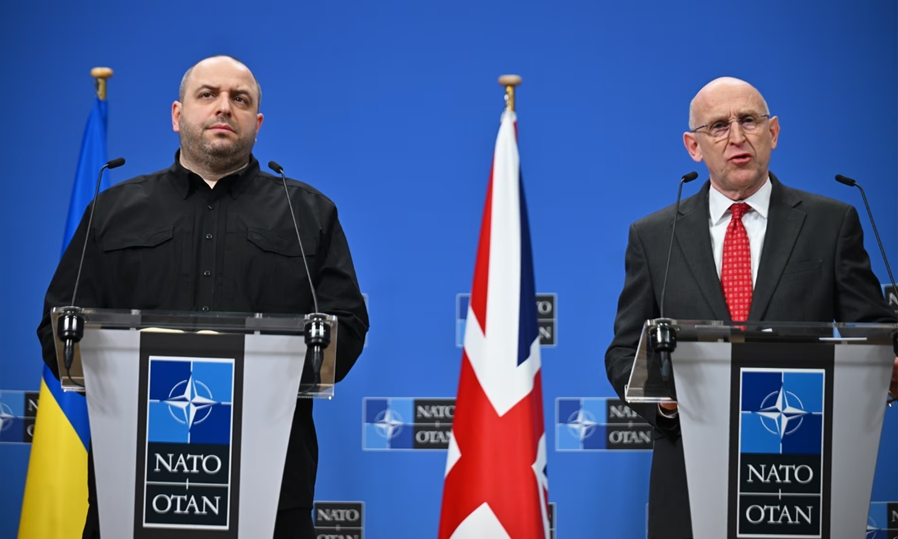
Ukraine’s allies have announced a record €21bn (£18.2bn) in extra military support for Kiev and accused Vladimir Putin of stalling and delaying US-led talks on a ceasefire deal.
Speaking at a meeting of the Ukraine defense contact group, in Brussels, British Defense Secretary John Healey said the Russian president had rejected a 30-day pause in fighting proposed a month ago by Donald Trump.
Healey said: ‘Putin has said he wants peace but has rejected a full ceasefire. His forces continue to fire on Ukraine, on military and civilian targets alike.”
Britain and Germany jointly convened the Ramstein meeting on Friday, which was attended by more than 40 countries but not the US. Pete Hegseth, Trump’s defense secretary, joined by video instead.
German Defense Minister Boris Pistorius downplayed the Trump administration’s absence. He acknowledged that peace “seems to be unattainable in the immediate future” and said Ukraine is at the “epicenter of a wider conflict.”
“It is between freedom and oppression, between recognizing global norms and aggressive imperialism, between democracy and authoritarianism,” Pistorius said, adding that military support for Ukraine would continue.
US attempts to end the war quickly have so far failed. Trump’s special envoy Steve Witkoff held talks with Putin’s investment adviser Kirill Dmitriev in St. Petersburg on Friday. This followed a visit last week by Dmitriev to Washington.
Witkoff was also due to meet with Putin, while the Kremlin has warned not to expect any progress and “nothing of substance”.
In talks with the White House, Russia refused to make concessions. Moscow is demanding control of four Ukrainian regions, the ouster of Volodymyr Zelenskyy’s pro-Western government and a ban on Ukraine’s NATO membership. He also wants sanctions lifted.
Trump issued a rare warning to Putin ahead of the meeting on his social media platform Truth Social. “Russia needs to get moving. Too many people are [sic] dying, thousands a week, in a terrible and senseless war – A war that should never have happened and would never have happened if I were president!!!,” he wrote.
Trump has previously said he is “upset” at Putin’s failure to stop the fighting, but has taken no serious steps to pressure Russia’s president. In interviews, Witkoff has parroted the Kremlin’s views, telling former Fox News anchor Tucker Carlson that Russian-occupied Ukrainian regions voted to join Moscow.
The US envoy to Ukraine, General Keith Kellogg, appeared to echo such suggestions in an interview with the Times on Friday, in which he said a demilitarized zone between Ukrainian and Russian forces could be established along the existing front line.
He also said British and French troops could adopt zones of control in the west of the country as part of a “reassurance force”.
“You could almost make it look like what happened with Berlin after World War II, when you had a Russian zone, a French zone and a British zone, an American zone,” he said.
Since Ukraine accepted a US ceasefire last month, Russia has dramatically stepped up its aerial bombing campaign. This week it launched a major military offensive in the Sumy and Kharkiv regions, capturing several border villages.
There is speculation that Russia is trying to seize as much territory as possible between now and May 9, the day Russia celebrates its World War II victory, and before a possible peace deal.
Estonian Defense Minister Hanno Pevkur said, “This is why we need to speed up deliveries as soon as we can.”
Addressing the Brussels meeting by video, Zelenskyy urged his allies to supply new Patriot air defense systems. This week, a Russian ballistic missile hit a playground in the town of Kryvyi Rih, where Zelenskyy grew up, killing nine children and 11 adults.
“Our priority is air defense. The remaining unused Patriots in the warehouses of our partners should protect lives,” Zelenskyy said, adding that 10 more are urgently needed.
Speaking at a press conference after the meeting in Ramstein, Pistorius said Germany had already given four Patriot systems to Kiev and was waiting for more to be delivered. He said a global search is underway. “We will buy everything we can get,” he said.
Germany will supply four Iris-T air defense systems, as well as 15 Leopard 1 tanks, several reconnaissance drones and 100,000 artillery rounds, he added. Other governments have announced new contributions.
Healey said Britain and Norway would provide radar systems, anti-tank mines and “hundreds of thousands of drones” as part of a $560 million defense package on top of the £4.5 billion committed by Downing Street this year. The figure includes repairing military vehicles damaged on the battlefield.
Friday’s meeting did not clarify how many countries are prepared to send troops to Ukraine as part of a “coalition of the willing“. Speaking to the BBC, EU foreign affairs chief Kaja Kallas said, “Different member states have different views”. She added that discussions are still taking place.
The UK, France and the Baltic countries have said they would send troops on the ground in the event of a peace deal. AFP reported that six nations have signed up.
Healey said planning for the so-called reassurance force was “real, substantial and well advanced”. It envisages deploying foreign troops away from the 1,000km-long frontline and reinforcing existing Ukrainian ground forces, he suggested.
Russia categorically rejected the idea. Swedish Defense Minister Pål Jonson said Stockholm needed answers to “a number of questions” before it could make a commitment. “It is helpful if there is clarity of what this mission would entail and what we are doing – whether we are peacekeeping, deterrence or reassurance,” he said.
The United Kingdom has said the US military “backstop” – meaning full air cover – is essential for any mission to work. However, the Trump administration has ruled this out and indicated that Ukraine’s future security needs are now Europe’s problem.
The Biden administration set up the contact group for Ukraine’s defense after Russia’s large-scale invasion in 2022 and chaired the meetings. In February, the US relinquished that leadership role, handing it to London and Berlin. Hegseth said the Trump administration has priorities elsewhere – in Asia and on America’s own borders.
,,,, https://www.theguardian.com/world/2025/apr/11/ukraine-allies-promise-21bn-military-support-kyiv
Head of US military base in Greenland fired after JD Vance visit
Col. Susannah Meyers has been dismissed amid reports that she distanced the base from Vance’s criticism of Denmark’s surveillance of the territory
Miranda Bryant and the agencies
Fri Apr 11 2025 15.59 15.59 CEST

The head of the US military base in Greenland has been fired for criticizing Washington’s agenda for the Arctic island after JD Vance’s visit two weeks ago.
Col. Susannah Meyers, who has served as commander of the Pituffik space base since July, was sacked amid reports that she distanced herself from the US vice president’s criticism of Denmark and its surveillance of the territory.
Greenland has its own government but is also part of the Kingdom of Denmark, which previously ruled it as a colony and continues to control its foreign and defense policies. Donald Trump has repeatedly said he wants to acquire the island and has not ruled out military or economic force to do so.
The US Space Force said in a statement Thursday night that Meyers was removed Thursday as commander due to a “loss of confidence” in her ability to lead.
“Commanders are expected to adhere to the highest standards of conduct, particularly in remaining nonpartisan in the performance of their duties,” it added.
The statement did not elaborate further, but the US website Military.com said Meyers sent an e-mail to all Pituffik personnel on March 31 “apparently with the purpose of generating unity among airmen and guardsmen, as well as Canadians, Danes and Greenlanders working there, following Vance’s appearance.”
Vance visited the base on March 28 in a trip that was substantially altered at the last minute amid increasingly tense relations between the US, Greenland and Denmark. During the visit, he told troops that the US must gain control of the Arctic island to stop the threat from China and Russia. He also criticized Denmark, which he said “has not done a good job for the people of Greenland”.
The delegation was originally planned to be led by his wife, second lady Usha Vance, who was due to visit the capital, Nuuk, and a dog sled dog race in Sisimiut. But following the uproar over the timing after the election – the new coalition government had not yet been sworn in – plans were changed.
The Vice-President told a press conference at the base: “Our message to Denmark is very simple: you have not done a good job for the people of Greenland. You have underinvested in the people of Greenland and you have underinvested in the security architecture of this incredible and beautiful landmass.”
JD Vance accuses Denmark of neglecting Greenland and calls for self-determination – video
In his email, Meyers wrote: “I don’t pretend to understand current policy, but what I do know is that the US administration’s concerns discussed Friday by Vice President Vance do not reflect the Pituffik space base.”
Pentagon spokesman Sean Parnell said on X: “Actions to undermine the chain of command or undermine President Trump’s agenda will not be tolerated at the Department of Defense.”
Trump has said the US needs control of Greenland for national and international security.
The US Space Force said Meyers has been replaced by Col. Shawn Lee.
Meyers appears to be the latest in a Trump administration purge of senior military officers and commanders. Others include Air Force Gen. Tim Haugh, the director of the National Security Agency, and Vice Adm. Shoshana Chatfield, who served in NATO.
Joe Kasper, chief of staff of the US Department of Defense, said: ‘Civilian control of the military is a core principle of our armed forces. Actions to undermine the chain of command or undermine President Trump’s agenda will not be tolerated at the Department of Defense.”
The Danish defense department declined to comment. Pituffik Space Base has been contacted for comment.
New York helicopter crash was ‘completely predictable,’ activist organizations say
Calls to end nonessential traffic on city heliports after death of Spanish family of five adds to at least 38 deaths since 1977
Friday April 11, 2025 18.05 18.05 CEST
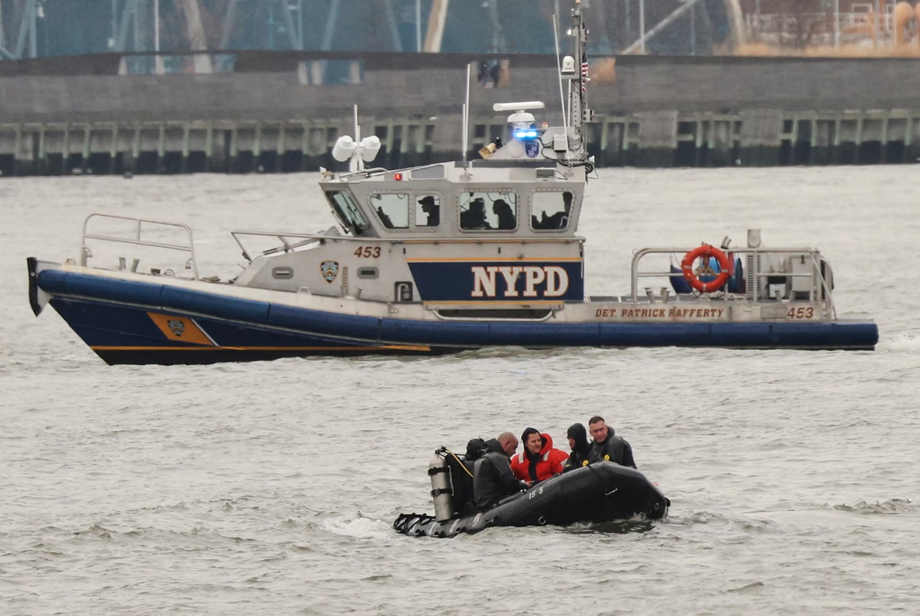
Thursday’s crash of a tourist helicopter on New York’s Hudson River that killed a pilot and a Spanish family of five was “completely foreseeable,” according to lawyers calling for the closure of three heliports in the region for nonessential traffic.
“Many of these helicopters are 30 or even 40 years old, and this one was 21 years old, which is still pretty old,” said Andrew Rosenthal, president of the group Stop the Chop, which has been advocating for an end to tourist helicopter travel over New York City and the New York-New Jersey metropolitan area.
“In New York, if you have a yellow cab, you have to get a new one every five to eight years, but here we let these things fly in the sky every 30 and 40 years. As far as I know, there’s no age limit, which is crazy.
“This was completely predictable and avoidable. If we had a rollercoaster that kills people every two years, we wouldn’t keep it running, but we have the same type of sky ride that kills people every two years, and we’re not changing anything,” he said.
Investigators are trying to determine the cause of Thursday’s crash, in which witnesses said they saw the helicopter break in midair and plunge in pieces into the river that connects Manhattan’s west side to New Jersey’s east coast.
Helicopter crashed into New York’s Hudson River – video
According to the Associated Press, at least 38 people have died in helicopter crashes in New York since 1977.
A collision between an airplane and a tourist helicopter over the Hudson River in 2009 killed nine people, and five died in 2018 when a chartered helicopter offering “open-door” flights crashed into the city’s East River.
Stop the Chop has documented a succession of other non-fatal incidents involving helicopters in and around New York City in recent years, and Rosenthal said it’s past time for city officials to put an end to tourist flights from the midtown Manhattan heliport from which the Bell 206 helicopter took off Thursday and from two other public heliports on the island of Manhattan.
According to Aviation Property Network, a specialized real estate company, the facilities generate a total of $2.7 million annually for New York in lease payments from companies that operate more than 42,000 tourist trips annually.
“The mayor could close the heliport in midtown Manhattan tonight if he wanted to, with the stroke of a pen and without the need for any other legislation,” said Rosenthal, whose group said more than 30,000 flights have taken off from there.
“This is not the first accident but one in a long series. It is predictable. It will happen again, it’s just a matter of numbers. We agree police, military, government, news, they are considered essential in our definition, but these non-essential flights are not necessary at all.”
New York Mayor Eric Adams was asked Friday about the tourist flights on Good Day New York.
“After any form of malfunction, accident or provocation, sometimes that’s the immediate [thought] … should we ban helicopters or should we not have that kind of tourist attraction in our city,” he said.
“We had 65 million tourists come to the city last year. That’s all part of the attraction of being in New York. People want to see the city from the sky.
“What’s crucial is like any airport or any aerial device, that’s done with proper maintenance and proper safety. And that’s what this investigation will determine.”
,,,, https://www.theguardian.com/us-news/2025/apr/11/new-york-helicopter-crash-safety
Dr. Stanley Weeks on informing maritime strategy and making a strategic difference
In 2021, CIMSEC launched a series of interviews about U.S. Navy maritime strategy since the 1980s. Through discussions with those who helped design and sustain this historic strategy, important lessons emerged about the maritime dimension of great power competition.
The 1980s Maritime Strategy was published in unclassified form in January 1986 and had been briefed and discussed extensively by Navy leadership several years earlier. The strategy marked a major change in the Navy, including from being a force that would have been primarily engaged in continental supply and defensive convoy escort in the event of World War III, to a force that would instead pursue a comprehensive, full-scale offensive against the flanks of the Soviet Union. The strategy also emphasized the Navy’s value in peacetime crisis response and the importance of forward presence. Among the things that make the strategy historic and unique, what is remarkable is how broadly it aligned naval leadership with how the Navy would be used in peacetime and in conflict and how it explicitly and unabashedly laid out a general scheme of offensive operations for how it would fight the great power war.
There is a deeper story to the strategy that is also historical and goes beyond unclassified publications and public statements. The story of how the strategy came to be, of how the Navy strategist community assembled, debated, and embedded the strategy into the institution of the Navy is a story worthy of the highest consideration.
CIMSEC interviewed selected individuals to tell that story and capture valuable lessons about how the Navy can consider maritime strategy in the context of great power competition. We thank these individuals for their excellent contributions.
Text by Dmitri Filipoff
CIMSEC discussed maritime strategy in the 1980s with Dr. Stanley Weeks, who, as a Navy lieutenant commander, helped assemble the first iteration of maritime strategy in 1982. In this discussion, Weeks analyzes how the briefing came about, how it quickly moved up the chain of command, and how maritime forces can make a strategic difference in great power conflict.
Once you received your initial strategy brief and became an action officer, how did you see the gravity and scope of what was being asked of him?
I felt there was a great opportunity for the Navy and Marine Corps team to reclaim and be recognized for a leadership role in the overall U.S. defense strategy. With a new administration committed in broad strategic terms to an enhanced maritime role and to ensuring that funds and resources will be made available to support that role, it would have been a grave mistake for the Navy not to articulate a clear and detailed strategy to justify this lead role.
How was the maritime strategy briefing developed in terms of how it was developed and what sources were consulted?
The maritime strategy briefing was produced very quickly in September/early October 1982. Although I was a junior officer (pre-XO LCDR) in the CNO Strategic Concepts Group office (OP-603), I was asked to be the action officer for the development of the maritime strategy, which the then VCNO Admiral VCNO had requested to kick off the CNO’s annual budget process. I drafted the brief in a few weeks in early September 1982, primarily on the basis of my own operational and academic experiences (including a Ph.D. in international relations and having just come from 13 months at sea conducting NATO multinational operations Standing Naval Force Atlantic (STANAVFORLANT) for British and Dutch admirals). It also drew heavily on the work I did in the early summer of 1982 as the cooperation officer for the first rounds of combatant commanders’ tank briefings for President Reagan.
After my initial drafting work, the Navy office coordinating budget matters provided an officer, Commander Spencer Johnson, who added more detail to the defense planning elements of the briefing. Then, after a brief review by our branch chief and OP-06 (both acting at the time), the maritime strategy briefing went to the 2-Star Program Development Development Review Committee (PDRC) in late September 1982. In a highly unusual move, they blessed it on the spot and directed it to go, within a week, to the NOC and its 3-star deputies on the NOC Executive Council. They received the briefing in the first week of October, 1982, and the new CNO, Admiral Watkins, approved the strategy that day – which was then briefed to Secretary of the Navy Lehman, who named it in accordance with his overall strategic thinking and the best product he had seen as Secretary.
In piecing together the war plans of the various theater commanders, did you see much friction or alignment in how they came together and how they planned to use naval power in the conflict?
We saw that, if properly articulated by the Navy, there was a basic symmetry between a maritime strategy of pressuring the Soviets in the Pacific Northwest and the North Atlantic/Norway Sea to threaten the preferred Soviet concentration on the central front in Europe and thereby enable the Navy to make the strategic difference in a major conflict. Admiral Hayward, as CINCPCPACFLT before he became CNO, had already indicated such a concentration of pressure in his Pacific strategy several years earlier. Although the CINCECEUR Commander’s strategy briefing to the Joint Chiefs of Staff and the President just held in the summer of 1982 made little mention of the role of the Navy/Marine Corps in that theater, NATO had a new NATO Concept of Maritime Operations (which the then Admiral of the UK Royal Navy, Sir James Eberle, shared with me in draft in 1981). and CINCUSNAVEUR London reflected this in their planning. The biggest problem I pointed out in our briefing to the CNO Executive Committee was that the theater commanders in the Atlantic and Pacific assumed that they could allocate many of the same maritime forces to them. This “fat” would need to be highlighted and then trimmed in our presentation to the NOC Executive Board to ensure that the maritime strategy is operationally realistic.
What were some of the underlying principles and conclusions from the maritime strategy briefing? How original and innovative were these concepts at the time?
The basic principles were, as noted above, “total pressure,” to position and use U.S. and allied maritime forces in a peacetime, crisis, and conflict presence to pressure the Soviets on their flanks to threaten their homeland (including, at the highest strategic level, their nuclear forces in bastions) and thereby deter conflict. If deterrence failed, the U.S. would threaten Soviet attention to a rapid and overwhelming victory on the Central Front in Europe – all to use maritime forces to make the strategic difference and ensure a favorable end to the war. The originality of this strategy was the articulation of how the maritime element of the national military strategy (and so we called it, despite the slander later cast on a “service strategy”!) would, in the circumstances of the day, coordinate a comprehensive maritime response in multiple theaters using classic forward and away pressure.
How was the briefing received by his audience? What kind of subsequent action did it precipitate?
As indicated above, the briefing was surprisingly well received and endorsed within ten days by both the Program Development Review Committee and the NOC and its NOC Executive Council. In the Executive Committee deliberations, the NOC called for further action to improve certain aspects of readiness and munitions (which had been overlooked) and to emphasize the role of allies. Under the leadership of the officer who replaced me as OPNAV Maritime Strategy Action Officer in March 1983, when I returned to sea for my XO tour, my excellent office mate Peter Swartz, the strategy underwent annual improvements (with many more aspiring cooks now lined up at the pot to no doubt help complicate Peter’s days!) until it was finally published in unclassified form in the January 1986 USNI Proceedings article by Admiral Watkins. (I confess to this day that to this day I don’t like to see references to the “1986 Maritime Strategy” because that was essentially the October 1982 Maritime Strategy.)
Why did the Maritime Strategy “work”, if it worked, and what has been difficult to replicate since then with the process?
I like to think that the Maritime Strategy was a success because it clearly articulated, in a way that was accepted within and (largely) outside the maritime services, how maritime forces would make a strategic difference in the strategic context of the time. Perhaps the best measure of our strategy’s success was that it became the basis for nearly a decade for how the maritime services budgeted their forces and how they planned and exercised those forces. As Secretary of the Navy Lehman Lehman’s recent book, Oceans Ventured, indicates, such force postures and exercises had begun as early as 1981 based on the broad outlines of the new administration, even before the more detailed maritime strategy of October 1982 was formally formulated and approved. When I commanded the flagship of the 1987 Baltic Operations and the NATO STANAVFORLANT flagship STANAVFORLANT USS Hayler (DD-997), such exercises were in full bloom.
What lessons can be learned from the Maritime Strategy of the 1980s to engage in modern great power competition?
Leaders need to clearly articulate how the maritime forces element of the National Military Strategy will make a strategic difference to deter great power conflicts and, if not deter, threaten vital strategic geography and enemy forces to help end the war on terms favorable to the US and its allies.
Based on this articulation of strategy, maritime force leaders must press relentlessly for funding for the necessary maritime forces, but ensure a force balanced in readiness and numbers – and ready to work together with the other services and allies.
US allies are still a vital political and military force multiplier in a way that other major powers are not. Each ally is a relationship that routinely requires cultivation – and, when frustrations arise, requires us to remember Churchill’s observation that the only thing worse than fighting a war with allies is fighting without them.
Dr. Stan Weeks has extensive experience in strategic and operational planning in business, defense, foreign policy, and international and regional security contexts. He joined Science Applications International Corporation (SAIC) in 1990 after a prior 24-year career in the U.S. Navy, including on the OPNAV staff as the first action officer and Maritime Strategy Editor in 1982-1983 and served as an OSD exchange officer in the State Department’s Bureau of Political-Military Affairs. From 1994 until his retirement in 2016, he was also an adjunct professor at the Naval War College, teaching the National Security Decision Making (NSDM) graduate course (Strategy and Force Planning and Executive Leadership) to Washington-area students in the military, government agencies, and congressional staffs. From 2007 to 2012, Dr. Weeks was an Adjunct Professional Staff Fellow at the Institute for Defense Analyses (IDA), supporting the Secretary of Defense and the Chairman of the Joint Chiefs of Staff, where his work included Asia-Pacific engagement and force posture, defense planning scenarios for QDR 2010, counter-piracy strategy, and the drafting of a new national defense strategy. From 2009 to 2011, he was a research analyst at the Center for Strategic Studies at the Center for Naval Analyses (CNA) (where he authored the study on recent developments in joint and service strategies). His education includes: U.S. Naval Academy 1970; Olmsted Scholar, University of Madrid, Spain 1974-76, Ph.D. and graduate studies in Latin America; M.A. 1973 and Ph. D. 1977 in International Studies, American University; School of Strategy, National War College 1988-1990.
Dmitry Filipoff is CIMSEC’s online content director.
Source: here
Will Iranian-backed Iraqi militias disarm?
Due to Iraq’s position in the region, armed paramilitaries pose a growing challenge to stability.
Iran-backed militias continue to play an important role in the politics that determine Iraq’s future. The militias are under the umbrella of an armed paramilitary force called the Popular Mobilization Forces (PMF). Together, the militias number more than 200,000 people, although estimates vary. They play a role across much of Iraq, from the Nineveh plain near Mosul to Anbar province on the border with Syria. There are growing calls for the government to rein in these groups and reduce Iran’s outsized influence in the country. However, armed militias rarely go away easily.
On April 7, Reuters reported that it had spoken to several militia commanders and that they were considering disarming. The report claimed that this was being considered to “ward off the wrath of Trump [sic]”. Apparently the militias have seen the US bombing the Iran-backed Houthis in Yemen since mid-March and are considering what’s next for their role in Iraq. At the same time, another report in The Times indicated that Iran is sending long-range surface-to-surface missiles to the militias.
Could both reports have a grain of truth? The militias could be sending messages to the international press that they are thinking of “disarming”. At the same time, some of them are also receiving offensive weapons. Militias have received Iranian missiles and drones in the past. In 2018, Iran also transferred ballistic missiles to Iraqi militias. However, these appear to have been of more limited range.
Groups like Kataib Hezbollah, for example, have used drones to target US soldiers. One attack killed three people and wounded over forty US personnel in Jordan in January 2024. Kataib Hezbollah is very close to Iran’s Islamic Revolutionary Guards Corps. It is also a key part of the Popular Mobilization Forces. As such, it is difficult to determine where Iran’s role ends and the Iraqi government’s role in command and control of the militias begins.
Kataib Hezbollah has rejected accusations that it is disarming. This sets a potential collision course for the future. The militias could acquiesce to US pressure by placing weapons in official Iraqi military warehouses so that their use could be monitored. Iraq’s militias face these key questions as Iran moves forward with indirect talks with the Trump administration. This is also happening while the US carries out attacks on the Houthis and there is pressure on Hezbollah in Lebanon to disarm.
It is therefore worth considering this wider context. The militias in Iraq may be under pressure to reduce their role as part of an Iran deal with the US. On the other hand, it could also require institutionalization within the Iraqi military system through favorable legislation and an increase in pay for members.
In Congress, Rep. Joe Wilson (R-SC) introduced a bill in early April to create an “interagency strategy to liberate Iraq from Iran.” The bill would cut off funding to the militias, designate them as terrorists, and halt security assistance to Iraq until Iraq takes steps to eliminate “Iran-backed puppet militias.”
The militias and their leaders will not give up their influence easily. Qais Khazali, the leader of the Asaib Ahl Ahl al-Haq (AAH), was once a detainee of US forces at Camp Cropper. He is a sanctioned terrorist. He gave a speech at the end of Ramadan claiming that there is an Israeli-backed conspiracy to divide Syria and Iraq. This is the kind of rhetoric that will have to be confronted to pressure groups like the AAH to reduce their role in Iraq.
Because of Iraq’s position in the region, the militias pose a growing challenge to stability. For example, they threaten Jordan, which is a key partner of the West. They could also threaten Syria, where a new government is taking shape as it tries to unify the country after more than a decade of civil war. They also now have long-range weapons to threaten US military assets and Gulf nations. As such, the militias are at a crossroads in the region. The battle for Iraq’s future will continue to revolve around the militias unless a solution is found to their role in Iraq.
Seth Frantzman is the author of Drone Wars: Pioneers, Killing Machine, Artificial Intelligence and the Battle for the Future ( Bombardier 2021) and an adjunct fellow at the Foundation for Defense of Democracies.
Source: here
The world to come: the return of Trump and the end of the old order
To survive, a multipolar world will require more, not less, international cooperation to combat climate change and prevent another financial crisis or military conflict.
Editor’s note: The following is adapted from the first and last chapters of the forthcoming book World to Come: The Return of Trump and the End of the Old Order by Mathew Burrows and Josef Braml. It is reprinted with permission of the publisher. The excerpt has been edited for style and clarity.
“The old world is dying, the new world is struggling to be born,” wrote the Italian philosopher Antonio Gramsci at the end of the First World War. Witnessing the rise of fascism in Italy, Gramsci understood that transitions can be dangerous. Today’s world is at a similar inflection point. With Donald Trump victorious in the 2024 presidential election, the Western liberal order presided over by the United States since the end of World War II is over. How will America, Europe and the rest of the world handle this inflection point?
With Donald Trump’s second victory, America has closed the door on the post-World War II liberal order. It has been some time since American leaders and the American public believed in the efficacy of multilateral institutions, such as the United Nations, the International Monetary Fund and the World Bank, that former American leaders created to secure peace, stabilize the world economy and end global poverty. This idealism persisted into the early years of the post-Cold War era, when President Bill Clinton believed that globalization would lift all boats and that other nations would come to resemble America. With the end of the Cold War, democracy, free markets and American leadership were humanity’s destination in the dream world of the American elite.
Washington was one of the first to be disillusioned, coming to see globalization as a nightmare, accelerating the rise of its competitors. Whole industries and American jobs migrated to Mexico and China. The US tried to impose democracy in Iraq and Afghanistan, which went disastrously. The financial crisis of 2008 undermined US financial credibility and Americans’ confidence in their own system; the financial sector – too big to fail – was bailed out, while individuals were left to struggle to keep their homes and jobs.
The late 1990s saw the beginnings of a populist movement that Trump exploited masterfully, taking it to the White House. Trump had all the hallmarks of his populist predecessors: he spoke bluntly and made much of the fact that he was not a professional politician. His over-the-top language and manner appealed to the disaffected and marginalized. His claims of wealth and business success captivated those who wanted a return to the American dream.
His 2024 victory was even bigger than his 2016 victory, attracting the support of black and Hispanic men and young people in addition to the white working class. More working-class voters voted for Trump than for Kamala Harris, turning the Democrats into the party of the rich. Voters forgave him for the failures of his first term, especially his mishandling of the pandemic. Few other politicians have understood the economic and social changes that have caused many to give up on the American dream. Inequality rose to unprecedented heights.
Despite being born rich, he has managed to connect with the poor and disaffected. In the short term, he would make them feel good with lower taxes and an end to the influx of millions of so-called illegal immigrants that workers feared would take their jobs. Both parties were enamored with protectionism that would lock out American industry, ceding many industrial sectors to China, especially in green technologies.
Neither party has a plan to reduce US fiscal deficits and debt, and both Republicans and Democrats are big spenders. Rising debt is a ticking time bomb. Trump is tempting fate with a series of new tax cuts that could add trillions to the debt. Trump is betting the inevitable reckoning won’t happen on his watch.
Trump deludes himself that higher customs revenues will make up for the lack of revenue from tax breaks. He said at his inauguration that “Instead of taxing our citizens to enrich other countries, we will tariff and tax foreign countries to enrich our citizens. To this end, we are setting up the Foreign Revenue Service to collect all tariffs, taxes and revenues. There will be massive amounts of money pouring into our Treasury from foreign sources.” For Trump, tariffs are a universal weapon . Their threat is designed to persuade friends and foes alike to respect US interests.
Under Trump, there may be less talk of war with China, but achieving US-China harmony seems unlikely. Although Trump avoids aggressive neoconservatives, he is still influenced by some anti-China advisers. His effort to decouple from China will likely harm the US economy. Even if he does not fully continue with “friendshoring”, the chances of reviving global or regional trade, as in the Obama era, are slim.
Trump’s disregard for the plight of others will be a problem for the West and an even bigger one in the short term for the Global South. Already, Biden has lost the plot about the developing world, and Trump is even more ignorant. Africa and other developing countries are drowning in debt because of the additional health costs of the pandemic. After globalization has lifted millions out of poverty, the number of poor people is rising again, while Western assistance is falling.
There are now several inter-state conflicts every year, most of which get little mention in Western media. The civil war in Myanmar has resulted in more than 50,000 deaths and 3 million displaced people, while the internal conflict in Sudan has resulted in the deaths of almost 150,000 people in the last two years, along with more than 3 million displaced people. None of these conflicts occurred during the US elections. Climate change and the associated struggle for increasingly scarce resources will exacerbate conflicts between and within states, and Washington’s lack of concern will affect America’s global leadership.
Trump thinks climate change is a farce, preferring “drill, baby, drill,” as he repeated at his inauguration to ensure fossil fuel independence. However, on the current course, temperatures will likely rise 2.9°C above pre-industrial levels this century. Like King Canute trying to stem the tide, Trump’s denialism won’t prevent increasingly powerful hurricanes from hitting the southeastern US or putting out the wildfires in the western US so vividly seen with the recent devastation of Los Angeles. Scientists already see a weakening of the Gulf Stream producing higher sea levels and the prospect – if it disappears – of freezing temperatures in North America and Europe. However, most of the climate burden will fall on poorer countries, which are more vulnerable to shocks and lack the resources to implement adaptation measures.
Trump pays little attention to the Global South. When the new president looks at the world, he only sees big players like China or Russia. The rest of the world is unclear to him, and the idea that countries in the Global South are middle powers with a say in the global system is incomprehensible. To him, you’re either for or against the United States. Trump is not ready for multipolarity.
It is unlikely that at the end of Trump’s term, there will be a better reckoning with America’s supremacy in the international order. American diplomacy is not prepared for concessions or compromises in building a new order based on the balance of power. Unipolarity – though outdated and no longer feasible – remains ingrained in the psyche of the foreign policy elite. Trump’s desire to see less involvement in overseas wars may be positive, but his disengagement from the world could turn into a damaging isolationism.
To return to the Gramsci quote that opens this chapter, at the end of his term in office, Trump will not finish dismantling the old order – the post-World War II order – nor will he be far from the path of rebuilding global cooperation. Like Xi and Putin, Trump wants to tear up the old order. There will be much destruction, but our deep hope and belief is that a new, fairer world can emerge from this chaos and that nations can build a new order that restarts global cooperation.
Preparing for a new era
There is no doubt that we face perilous times, a historic inflection point. Globalization has penetrated value-based trading networks; nationalism is on the rise everywhere, and major state-to-state warfare has returned, while the shift from West to East, along with a dizzying number of untested technologies, is accelerating. With international cooperation waning, we have lost precious time in fighting climate change, jeopardizing the planet and the quality of life for future generations. What are the hard lessons needed to change the current direction of states towards cooperation?
Lesson #1: Avoiding World War III
There are two ways the current impasse can be resolved. The first is war, which Harvard political scientist Graham Allison sees as the historical norm for resolving differences between two rivals. Under Biden, tensions flared and there were concerns that the United States and China were heading toward conflict over Taiwan, but both sides backed down. Putin has also raised the specter of nuclear war with his repeated warnings of using tactical nuclear weapons to deter Western support for Ukraine.
The second way is to learn from the past two centuries of great powers trying to live together in peace and apply them to international relations today. For the United States, it must understand that global hegemony is not sustainable. The price for sustaining it would be domestic bankruptcy and conflict abroad, which could lead to a nuclear holocaust. The balance of power worked after the Concert of Europe. If followed today, the United States would remain a great power, but it would have to recognize China and, in time, Russia as legitimate players, accepting that the world is multipolar and that America cannot set all the rules.
One US-China expert has suggested that Washington should declare that it approves of Taiwan’s unification with China if it is done peacefully. This would counter China’s belief that military force is the only way to avoid Taiwanese independence. In recent years, however, Washington has gone from helping Taiwan defend itself to claiming the island as a strategic asset it cannot lose without undermining its naval superiority in East Asia. It may take an event akin to the Cuban missile crisis to persuade both sides to reduce security competition and inaugurate confidence-building measures.
The Middle East is probably the most difficult of the three conflicts, given the number of players and the long-lasting wars. Annexing Palestinian territories will only instigate further unrest. Five million Palestinians cannot be suppressed indefinitely. Hamas and Hezbollah will not disappear, even if they have been severely weakened. Indeed, in the final days of the Biden administration, Secretary of State Blinken said that the US government assessed that “Hamas has recruited almost as many new fighters as it has lost.” Palestinian self-rule in the West Bank and Gaza is the only solution. Israel should accept help from Saudi Arabia and others to establish a Palestinian state strong enough to stop terrorists operating from its territory. It may be some time before Israelis have had enough of a relentless conflict. However, taking steps to annex the West Bank and Gaza could trigger conflicts between Palestinians and Jews inside Israel. The Trump administration will not want to pressure Israel, but the Europeans, Saudis and others should intervene and persuade the Trump administration against any Israeli recognition of the annexation.
The second way is to learn from the last two centuries of the great powers trying to live together in peace and apply it to international relations today. For the United States, it must realize that global hegemony is not sustainable. The price for sustaining it would be domestic bankruptcy and conflict abroad, which could lead to a nuclear holocaust. The balance of power worked after the Concert of Europe. If followed today, the United States would remain a great power, but it would have to recognize China and, in time, Russia as legitimate players, accepting that the world is multipolar and that America cannot set all the rules.
One US-China expert has suggested that Washington should declare that it approves of Taiwan’s unification with China if it is done peacefully. This would counter China’s belief that military force is the only way to avoid Taiwanese independence. In recent years, however, Washington has gone from helping Taiwan defend itself to claiming the island as a strategic asset it cannot lose without undermining its naval superiority in East Asia. It may take an event akin to the Cuban missile crisis to persuade both sides to reduce security competition and inaugurate confidence-building measures.
The Middle East is probably the most difficult of the three conflicts, given the number of players and the long-lasting wars. Annexing Palestinian territories will only instigate further unrest. Five million Palestinians cannot be suppressed indefinitely. Hamas and Hezbollah will not disappear, even if they have been severely weakened. Indeed, in the final days of the Biden administration, Secretary of State Blinken said that the US government assessed that “Hamas has recruited almost as many new fighters as it has lost.” Palestinian self-rule in the West Bank and Gaza is the only solution. Israel should accept help from Saudi Arabia and others to establish a Palestinian state strong enough to stop terrorists operating from its territory. It may be some time before Israelis have had enough of a relentless conflict. However, taking steps to annex the West Bank and Gaza could trigger conflicts between Palestinians and Jews inside Israel. The Trump administration will not want to pressure Israel, but the Europeans, Saudis and others should intervene and persuade the Trump administration against any Israeli recognition of the annexation.
The US has tried to implement regime change with its enemies too many times. Cornering Iran will only accelerate its determination to produce nuclear weapons. Washington would do better to reach out, as Trump campaigned on, but it will have to avoid maximum-pressure tactics that, instead of softening Tehran, will lead to another failed attempt at cooperation. Russia and China play growing roles and must engage in an effort to achieve regional peace.
Lesson #2: Cooperation over competition
Climate mitigation and adaptation efforts offer another chance to renew US-China relations and build trust. Protecting while ignoring global climate struggles is unsustainable. This must be a global effort; success depends on it. China’s role in green technology makes its cooperation vital. Why shouldn’t the United States and Europeans explore joint efforts with the Chinese and others, for example, to develop better and more sustainable batteries? The United States fears an expansion of China’s monopoly on battery production and wants to wean Western countries from any dependence on China and produce its own. Instead of competing with each other, some key technological innovations should be shared as public goods for the benefit of all.
American, Asian and European green technology value chains could be severely damaged if the US-China trade war escalates. True leadership in our multipolar world involves addressing global issues, not just self-interest. The West must show that it is considering wider interests beyond its own to maintain its influence. Isolation behind its own “wall of democracy” and ignoring the wider world will prevent the spread of Western values and undermine our economic foundations.
China has become a world leader in renewable energy over the past decade and expects to surpass its 2030 solar and wind power target already in 2025. Its more affordable renewables are key to the transition to clean energy in developing countries. However, coal-fired power plants are on the rise, partly as a back-up for all the new wind and solar farms, and China is the biggest emitter of greenhouse gases. Despite its progress, China also needs to do more. Russia has the greatest potential for solar, wind and nuclear power, but the government’s reliance on oil and gas revenues to fund the war in Ukraine is a big obstacle to the transition to green energy. Instead of confrontation, more cooperation is needed to combat global climate change and prevent another financial crisis.
Lesson #3: Avoiding the next financial crisis
In today’s multipolar world, international coordination would again be needed to reduce worsening macroeconomic imbalances that have the potential to turn into a crisis. These risks were evident during the global financial and economic crisis of 2007-2008, when global imbalances were large and a key factor in the spread of the crisis.
The imbalances are growing and will not be reduced by Trump’s tariffs and decoupling of supply chains, but by long-term structural adjustment processes: surplus countries like Germany and China should save less and consume more. Such a move by Germany would also strengthen Europe’s political unity. Chinese leaders are only likely to favor a return to a consumption-driven economy if tensions with the United States ease. Deficit countries like the United States should save more and reduce deficits and public debt, which also promote macroeconomic imbalances.
As long as the United States has a budget deficit, it will have trade deficits, and the twin deficits – budget and trade – are partly a consequence of a strong dollar. Measures should therefore be taken to reduce the structural overvaluation of the dollar as well as to force a correction of the undervalued Chinese yuan. John Maynard Keynes proposed a global trade and capital regime in 1944, which involved a synthetic currency designed to absorb global imbalances, such as a supranational currency based on special drawing rights of the International Monetary Fund. However, none of the major players – the US, the EU and China – would want to coordinate their monetary and fiscal policies in such an arrangement, which would be seen by all as a loss of sovereignty.
Even another Plaza Accord that sought to appreciate the yuan against the dollar and try to reduce Chinese exports is unlikely. The 1985 Plaza Accord was a deal Washington struck with its allies to save the United States by appreciating its own currencies. America is in a similar situation to today, buffeted by inflation and suffering high fiscal and trade deficits. China has undoubtedly absorbed the lesson Japan has learned. By helping the United States, Japan increased the value of the yen, making its exports unaffordable and ushering in the long deflationary decade at home.
More practical might be an informal but regularized trilateral mechanism by the heads of central banks and treasuries – the United States, the European Union and China – to share views on threats to global financial stability and the necessary macroeconomic changes each should make. Establishing such routine, high-level and confidential exchanges will not necessarily prevent another financial crisis, but it could help speed up the rapid decision-making needed in the event of a crisis. As in 2008, financial crises often require quick agreements to avoid further escalation. Routine high-level discussions would also build trust and facilitate solutions to other problems, such as the debt crisis in poorer countries.
Lesson #4: Inclusiveness: a more representative multilateral system
Historically, the best time for multilateral reform was when there was a recognized global hegemon. Paradoxically, with multipolarity, it is harder to reform with various rising powers vying for a permanent place and suspicious of changes that might favor their opponents. UN Security Council reform has therefore been stymied. While the UN membership grew from fifty-one to 185 countries, the Security Council seats increased from eleven to fifteen in the mid-1960s. The five permanent members were victors in the Second World War and each retains a veto. The ten non-permanent members represent different regions and serve for only two years.
Without such a reform of the UN Security Council and other multilateral institutions, developing countries would tend to put more hope and trust in bodies founded by Russia and China, such as the BRICS, where their voices are more likely to be heard. Competing multilateral bodies will increase confrontation and undermine the cooperation needed to enable a sustainable and peaceful future.
Woodrow Wilson, the twenty-eighth President of the United States, failed to achieve a more peaceful new world order at the end of the First World War, not least because of domestic restrictions against the United States joining the League of Nations and assuming a greater global role. Isolationist and protectionist voices prevailed in US foreign policy – a unilateralist and introspective one, shrugging off “extra-emispheric” security commitments and moving away from international economic cooperation. We all know how this story ended: a Second World War.
It is not just about avoiding catastrophe; it is about creating a future in which shared prosperity, security and sustainability become the foundation of a truly global order. The alternative is not just failure – it is the collapse of everything we value.
Dr. Mathew Burrows is an advisor and program leader of the Stimson Strategic Foresight Center. Prior to joining Stimson, he had a distinguished career in the State Department and the Central Intelligence Agency (CIA), the last ten years of which he spent at the National Intelligence Council (NIC).
Dr. Josef Braml is Secretary General of the German Group and European Director of the Trilateral Commission – an influential global platform for dialogue between America, Europe and Asia. He previously worked at the German Council on Foreign Relations (DGAP) from 2006 to 2020.
Source: here
Trump was right to fire Vice Adm. Shoshana Chatfield
The time for double standards is over. An apolitical military must be apolitical and focused on the task of winning wars.
U.S. Navy Vice Admiral Shoshana Chatfield, who served as the U.S. military representative to the North Atlantic Treaty Organization (NATO), has blazed a remarkable trail.
Chatfield’s military credentials are indisputable. From serving as a helicopter pilot – flying the SH-3, CH-46D and MH-60S – he went on to command the Helicopter Support Squadron (HC-5) and the Helicopter Sea Combat Squadron (HSC-25).
Chatfield then led a joint reconstruction team in Farah Province, Afghanistan, in 2008. She was also the first woman to serve as president of the prestigious Naval War College.
Shots heard around the world
However, according to Pentagon spokesman Sean Parnell, “Secretary [Pete] Hegseth has removed US Navy Vice Adm. Shoshana Chatfield as the US representative on NATO’s military committee because of a loss of confidence in her leadership ability.”
That announcement quickly led to a media firestorm and predictable criticism from Democratic lawmakers, who insist the firing was the result of chauvinism and accuse President Donald Trump of firing capable officers in favor of political cronies. For their part, Republicans have responded that Chatfield was the public face of the dreaded DEI (Diversity, Equity and Inclusion) that has gripped the minds of America’s military leaders for too long.
What very few commentators have noted, however, is that Chatfield – like the rest of those who work for the executive branch of the federal government – serves at the discretion of the sitting president. Trump and Hegseth fired Chatfield because they lacked confidence in her ability to lead. That might upset some people. It might even offend Chatfield and her supporters. But Trump doesn’t have to defend his decision or explain it; it’s just the way our system works.
This won’t do much to appease the media. But the truth is that Trump ran and was elected on a platform that promised to rein in perceived corruption and leftist ideological excess in every area of government. Part of that process involves placing people in leadership roles that fit Trump’s stated worldview, however mercurial.
Vice Admiral Chatfield disagreed with Trump’s worldview
And despite all the complaints from Chatfield’s supporters, the Vice Admiral has a public track record of making many statements in favor of DEI programs. Indeed, she is on record as “complaining that lawmakers in the House of Representatives [in 2015] were 80% male, proclaiming that ‘our diversity is our strength,'” according to Fox News’ Michael Dorgan.
Indeed, Chatfield’s remarks about Congress come dangerously close to politicizing what is supposed to be an apolitical role. When has it ever been acceptable for an official to openly criticize Congress for any reason? For that matter, if Chatfield were a man and had declared his aversion to having women in Congress, would anyone have objected if he had been quickly removed from office with minimal debate?
Chatfield should not get an endorsement because the situation is reversed. The truth is that in 2015, such discussions were acceptable – and even fashionable. Consequently, at the time, Chatfield was relieved of existing powers. But those comments are forever etched in the record. Chatfield is not immune from dismissal just because he made those comments a decade ago.
Nor was that statement a mere statement on Chatfield’s part. In 2023, she described herself at the top of her LinkedIn page saying: “Talk about #navalaviation and #dei”. That same year, she wrote on LinkedIn, “I got my wings in ’89 and never thought I would be a member of the Flag Mess sitting next to the CNAF [Commander of Naval Air Forces] at the 2nd Annual DEI Conference in ’22!” It is worth noting that these posts were deleted from Chatfield’s LinkedIn, but have been preserved by the conservative website The Daily Signal.
The above statements blur the line between Chatfield’s personal views and his professional preferences. And these stated positions are fundamentally at odds with both Trump, and Hegseth.
Compare Chatfield’s experience with that of a former colleague of mine who used to teach counterinsurgency at West Point. An Iraq War veteran, this individual wrote a humorous essay praising Trump’s infamous 2017 “covfefe” tweet as an example of Trump’s “very powerful […] ability to persuade.” As a result of this short and funny essay, his career – and the heroics that have defined it – has been criticized on the grounds that he “got political.” If his essay had mocked Trump, however, you can bet that his comments would have been ignored or perhaps even celebrated, as Chatfield was.
The time for double standards is over. An apolitical military must be apolitical and focused on the task of winning wars. Chatfield was the example of Biden-era DEI policies that Trump criticized against. So she was let go. Q.E.D..
Presidents fire people all the time
Let’s not forget that Chatfield is not the only Biden-era military leader to lose his position since Trump took office. Again, this has been a fairly common practice that newly elected presidents have engaged in – and they’ve only been embroiled in media controversies when Republicans have.
Indeed, sometimes Republicans even fire Republicans! A former U.S. ambassador who, before becoming ambassador, served on Ronald Reagan’s national security council once told me about the time Brent Scowcroft came to the White House as George H.W. Bush’s national security adviser during the transition from Ronald Reagan’s to Bush’s presidency. At the time, Scowcroft unceremoniously fired countless national security staffers. The former ambassador said, “It felt like a transition from a Republican administration to a hostile Democratic administration!” But no one outside the executive branch blinked.
Nor would Chatfield be the first officer with a stellar service record to be accused of irresponsible public policy remarks.
President Barack Obama fired U.S. Gen. Stanley McChrystal for inappropriate words uttered to a Rolling Stone reporter profiling the general. Some of our readers may even be old enough to remember when President Harry S. Truman replaced legendary US Army General Douglas MacArthur after he publicly criticized Truman’s handling of the Korean War.
Combat records and stellar service do not shield military leaders from being fired by their commander in chief. If the individual is not a good fit with the stated policies and politics of the acting commander in chief, he – or she – should go.
Don’t forget Trump’s NATO issue and Chatfield’s role there
Ultimately, Chatfield’s role as US military representative to NATO likely played a role in her firing. After all, Chatfield, as a Biden-era appointee, clearly did not share Trump’s views on NATO.
The issue of NATO and America’s future relationship with the alliance is quickly becoming a major flashpoint between Trump and the rest of the Washington establishment consensus. The president must avoid groupthink, of course. But he also can’t be surrounded by a group of officials virulently opposed to his worldview. After Chatfield’s ouster, she is likely to be replaced by an officer whose view of America’s role in NATO is closer to the president’s. This is not only appropriate but desirable.
In short, Chatfield’s dismissal was constitutional, acceptable, appropriate, and should not be controversial. But, as with everything Trump does, it’s now all Washingtonians can talk about – until they move on to the next scandal.
About the author: Brandon J. Weichert
Brandon J. Weichert, senior national security editor at The National Interest, as well as a contributor to Popular Mechanics, who regularly consults with various government institutions and private organizations on geopolitical issues. Weichert’s writings have appeared in a number of publications, including the Washington Times, National Review, The American Spectator, MSN, Asia Times, and countless others. Among his books are Winning Space: How America Remains a Superpower, Biohacked: China’s Race to Control Life, and The Shadow War: Iran’s Quest for Supremacy. His newest book, A Disaster of Our Own Making: How the West Lost Ukraine is available for purchase wherever books are sold. He can be followed via Twitter @WeTheBrandon.
Source: here
PODCAST – Sea Control 569: Dr. Peter Luebke on the U.S. Navy and innovation – By J. Overton
Dr. Peter Luebke of the Naval History and Heritage Command joins the program to discuss the collection of NHHC essays he edited titled “The U.S. Navy and Innovation: case studies of the 20th Century“.
Peter C. Luebke is a historian with the Naval History and Heritage Command. There he has worked on several projects, including Naval Documents of the American Revolution, The Autobiography of John A. Dahlgren, Richmond Kelly Turner: Planning the Pacific War, Contested Logistics: Sustaining the Pacific War , and The U.S. Navy and Innovation: Twentieth-Century Case Studies.
Download Sea Control 569: Dr. Peter Luebke on the U.S. Navy and Innovation
Links
1. The U.S. Navy and innovation: twentieth-century case studies, edited by Peter C. Luebke, U.S. Navy History and Heritage Command, September 2024.
J. Overton is co-host of the Sea Control podcast and has edited the essay collection Seapower by Other Means: Naval Contributions to National Objectives Beyond Sea Control, Power Projection, and Traditional Service Missions. Contact the podcast team at Seacontrol@cimsec.org.
Source: here
Breaking China’s control of shipping with the Multilateral Maritime Alliance
Text by Blaine Worthington
The United States has a shipping problem and everyone knows it. From combatant commands to Congress and maritime security checkpoints to the White House, everyone is talking about America’s lack of maritime capability.1 America , it seems, is waking up to its maritime problem and is ready to roll up its sleeves and start solving it the only way it knows how – largely on its own. Although there have been some signs of bilateral cooperation in shipbuilding, the United States has not made a concerted effort for a robust, multilateral maritime strategy against China. This needs to change. A coordinated, multinational approach is needed to counter Chinese dominance of shipping. The US and its allies should form a multilateral maritime alliance to secure maritime trade and build critical shipping capacity to support expeditionary combat operations.
The crux of the problem is that the United States cannot compete with Chinese shipping or shipbuilding. The U.S.-flagged merchant fleet currently has 185 ships.2 China (including Hong Kong) has a fleet of 7,838.3 In 2023, the United States built 0.1% of the world’s ships. In the same year, China built 50.7%.4 In 2024, 2.16% of the global merchant fleet was owned by US companies. China owned 19%.5 The scale of China’s advantage in shipping and shipbuilding gives it tremendous economic leverage over the United States in peacetime. At the same time, this lack of domestic shipping means that the United States does not have a merchant navy robust enough to sustain sustained expeditionary combat in the event of a conflict with China.Understandably, the United States wants to rebuild its maritime sector. It must and it must do it quickly.
However, the United States is not alone in this situation. Its close friend and ally, Australia, is suffering from a similar malady. As Canberra-based maritime expert Richard Dunley noted, “99% of Australia’s trade moves by sea, supporting 45% of the country’s national income. And virtually all of it travels in foreign-flagged and foreign-owned ships. In 2021, 6,170 individual foreign-flagged ships called at Australian ports. By contrast, there are only four Australian-flagged ships in international trade and these are LNG carriers, exporting Australian hydrocarbons to customers in North East Asia.”7
This is not lost on the Australian government either. Prime Minister Anthony Albanese and the Labor Party have made the development of a “strategic fleet” of privately-owned and Australian-flagged merchant vessels a centerpiece of the party’s platform during the 2022 elections.8 In 2023, the Albanian government released a report detailing the scope of the problem and proposing many solutions similar to those now offered in the United States, including government subsidies, cargo preference measures, and maritime workforce development efforts – largely measures aimed at strengthening domestic capacity.

BENGAL GULF (Oct. 17, 2021) Ships and aircraft of the U.S. Navy, Royal Australian Navy, Japan Maritime Self-Defense Force (JMSDF) and the U.K. Royal Navy transit in formation as part of the Maritime Partnership Exercise (MPX) (U.S. Navy photo by Mass Communications Specialist 2nd Class Haydn N. Smith).
These efforts, like their U.S. counterparts, will take many years, if not decades, to take effect. There is no switch that will suddenly cause the emergence of shipyards, full of trained and skilled workers, with a healthy, steady and reliable demand for American or Australian crewed and operated ships, relying solely on domestic solutions. As the Davidson window – the most likely window in which China might seek to take military action against Taiwan – closes and the clock ticks down to 2027, there simply isn’t enough time to wait for domestic industry to kick into gear.9
If domestic growth cannot provide an immediate solution, the obvious answer is to look abroad. In the United States, this effort has focused on the shipbuilding side of the coin. In a recent testimony, Congressional Research Service analyst Ronald O’Rourke illustrated this perspective by highlighting U.S. allies in Japan and South Korea as obvious partners to address U.S. shipbuilding needs.10 Australian officials seemed to have reached a similar conclusion by considering Japanese Mogami-class frigates in their upcoming procurement.11 These solutions, however, leave two problems remaining. First, all Japanese and South Korean shipyards are located in China’s weapons employment zone (WEZ). This is a concern not just for the US and Australia, but also for Japan and Korea, which would need access to shipyards with some Chinese standoff in the event of conflict. Second, even if shipbuilding partnerships can be realized in the medium term, the United States and Australia will not have sufficient shipping capacity to compete with China in the near term.12
To address these problems, the United States and Australia should engage with their regional partners in South Korea, Japan, and the Philippines-which have partnered with the Koreans to develop their own shipbuilding capabilities-to create a counter-China maritime bloc: Multilateral Maritime Alliance (MMA). The MMA would achieve the following goals:
1. Establish economic incentives to promote seaborne trade through ships owned or flagged in the MMA, protecting market access for domestic shippers and breaking Chinese economic leverage over member states.
2. Formalize cooperation among MMA members to develop shipbuilding and shipping capacity in Australia and the United States, establishing a robust and redundant allied maritime capability outside the WEZ.
To achieve the first objective, the MMA would need to negotiate collective cargo preferences, port privileges, and trade incentives to immediately shift demand away from Chinese carriers. Many countries, including the United States, maintain cargo preference policies that are designed to secure demand for domestically flagged shipping. Under the MMA, similar preference policies would be shared among MMA countries. Collective preferences could include requiring that a percentage of all imports or exports be carried on MMA shipping, offering first-line privileges for MMA ships in MMA member ports, and reducing or eliminating import tariffs for all goods shipped by MMA shipping. If necessary, the MMA could even resort to establishing shipping quotas to be shared by participating countries to ensure that all members have the opportunity to develop and sustain their domestic industries. By coordinating cargo preferences and other incentives, the MMA immediately counters China’s maritime dominance – a dominance achieved through decades of subsidies, artificially low freight rates and unfair labor practices.Breaking China’s control over maritime trade is a necessary condition for future domestic investment in shipping and shipbuilding to be globally competitive.
For the second objective, the MMA can create a formal dialog between countries to enable strategic planning and coordination of shipbuilding and ship repair capacity development. While many of these discussions are already taking place on a bilateral basis, the MMA would ensure that these existing actions are undertaken carefully, do not inadvertently compete with each other or compromise the strategic integrity of this shipbuilding or ship repair capacity. The MMA would effectively serve as an industrial alliance, similar to those found in the European Union. These alliances bring together academia, policy makers and industry to coordinate policies and investments to achieve strategic goals by finding opportunities for collaboration at all levels of the value chain.This could build on cooperative efforts such as the production of Virginia-class submarines under AUKUS or the potential Mogami-class procurement project between Australia and Japan. MMA collaboration could generate opportunities to jointly design, procure and build future vessels in ways that allow each member state to contribute strategically to the supply chain. In addition, the MMA could enable the development of formal technical and labor exchange programs that would allow U.S. and Australian workers and management to work alongside their Korean and Japanese counterparts to develop expertise in current best practices and bring those skills back to their home countries. It would also allow Korean, Japanese, and Filipino workers with shipbuilding experience and expertise to travel to the U.S. or Australia to seed their developing workforce and provide immediate access to the skilled labor needed to increase shipbuilding and ship repair capacity beyond the WEZ.
These solutions are not intended to replace efforts currently underway in the United States or Australia. These efforts to develop domestic maritime sectors must continue. However, purely domestic efforts to rebuild the industry will require time that neither country can afford, and bilateral efforts fail to effectively address the extent of Chinese anti-competitive practices and the strategic vulnerability created by the continued concentration of capacity within the WEZ. However, the MMA will set conditions to allow these inward investments to be competitive in the long term, breaking Chinese dominance of the shipping industry in the short term. It also formalizes strategic cooperation between all parties to ensure that collective risks are mitigated through collective solutions.
Ultimately, this civil maritime coordination will lay the foundations for further cooperation between Member States in the event of a conflict with China, when the demand for shipping is acute and all parties will have a role to play in meeting that need. The time for unilateral and bilateral action has passed. The United States, Australia, South Korea, South Korea, Japan and the Philippines should form the Multilateral Maritime Alliance now and break Chinese control of the shipping industries – before it is too late.
Blaine Worthington is a graduate of the UC San Diego School of Global Policy and Strategy and an associate at Booz Allen Hamilton. He is a graduate of the U.S. Naval Academy and served as a logistics officer in the U.S. Marine Corps and continues to serve as a member of the Marine Corps Independent Reserve. The opinions expressed are his own and do not represent the positions of any institution, corporation or government.
Source and references: here
Marine Lounge – an idea for Romania too?
The launch of the 46th edition of the Marine Marine Lounge, organized by the French Navy, the Marine Painters Association and the National Maritime Museum! The show will take place in the spring of 2026.
This event honors artists whose works are dedicated to the naval and maritime world: painting, drawing, engraving, photography, sculpture.
On this occasion, a national competition is open on the theme “400 Years of Art and Combat “, reflecting the 400 years of the Navy in 2026.
The works selected by the competition jury will be exhibited at the National Maritime Museum in Paris during the Salon.
The other aim of the competition: to nominate new Official Painters of the Navy (POM).
Artists can apply for the prestigious POM corps. This title, awarded by the Minister of the Armed Forces, honors artists dedicated to a contemporary representation of the maritime world, civilian and military.
Source: here
The US Navy is still struggling with problems with the elevator on its new Ford-class supercarriers
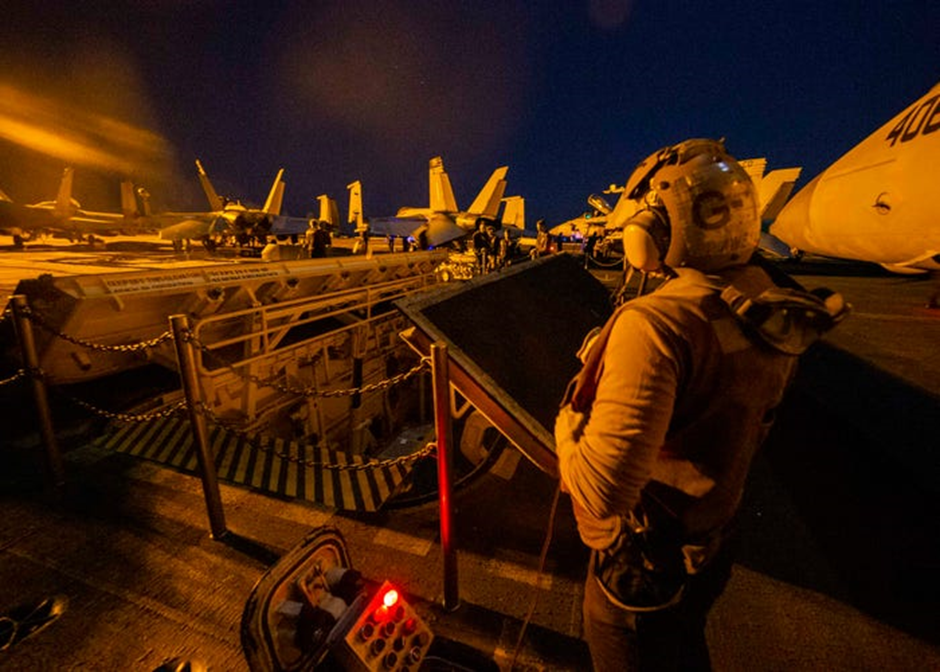
USS Gerald R. Ford sailors load a weapons elevator onto the flight deck. U.S. Navy photo by Mass Communications Specialist 2nd Class Nolan Pennington
1. The U.S. Navy’s next aircraft carrier is nearing completion, but faces challenges with its elevators, among other technologies.
2. Advanced weapons elevators were previously a problem on the USS Gerald R. Ford.
3. Navy officials suggested in written testimony before Congress that they could affect the new USS John F. Kennedy.
The U.S. Navy’s next Ford-class aircraft carrier is nearly ready, but could be hampered by challenges with the elevator, Navy officers and officials said this week.
It’s a bit of déjà vu. That same technology was at the center of the headaches for the USS Gerald R. Ford, the first of the Navy’s new class of supercarriers, and now elevators are a challenge as shipbuilders work to finish the next ship in the class.
“The John F. Kennedy (CVN 79) is nearly 95 percent complete and has a contract delivery date of July 2025,” Navy officials said in a joint statement before the Senate Armed Services Committee’s Seapower subcommittee hearing on the status of nuclear shipbuilding. “However, we are assessing this significant pressure to that date.”
Officials cited problems with some of CVN 79’s technologies, namely advanced weapons elevators and aircraft launch and recovery systems.
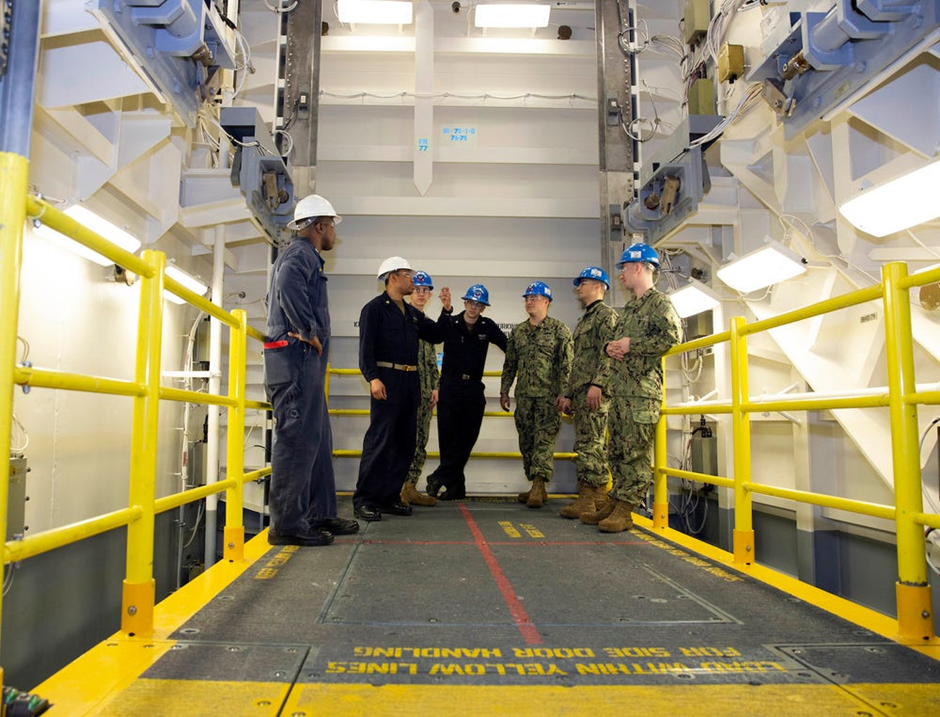
The weapons elevators are designed to move munitions to the flight deck. U.S. Command Specialist/Mass Comm. 1st Class Jeff Troutman
They said the pressure to meet the contractual delivery date is driven by “critical challenges, primarily in advanced weapons elevators and aircraft launch and recovery equipment.”
Officials added that while “initial class design challenges are being resolved,” some of the “challenges focused on early production and associated learning continue on CVN 79.”
Advanced electromagnetic-powered weapons elevators, advanced arresting gear, and the electromagnetic aircraft launch system were issues during the development and construction of the first-class USS Gerald R. Ford, which faced delays and cost overruns attributed largely to integration issues related to new systems and capabilities.
The elevators on the Ford, for example, were not installed when the carrier was delivered in May 2017, well past the original 2015 delivery target. The first of 11 weapon elevators arrived in December 2018.
The Secretary of the Navy at the time, Richard Spencer, staked his task on repairing the Ford elevators in early 2019, but the problem persisted past the deadline. In January 2020, then acting secretary Thomas Modly said the problem was “kind of a disaster” but noted that the service was “fixing the problem.”
In their joint statement Tuesday, Navy officials highlighted the successful deployments of the USS Gerald R. Ford, pointing out that the problem is in production, not design at this stage. They added that lessons learned are being implemented on CVN 80 and 81.
The Navy directed Business Insider to the joint statement when asked about specific problems with the weapons elevators and potential delays in delivery of CVN 79.
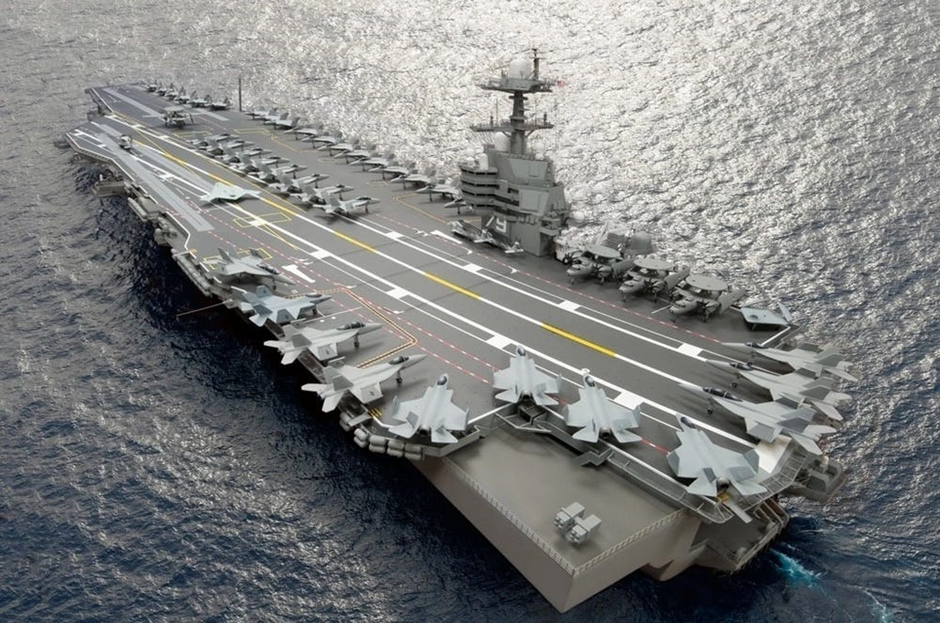
The aircraft carrier John F. Kennedy will be the second ship in the Gerald R. Ford class.
The Ford-class elevators are controlled by synchronous electromagnetic, linear motors, which effectively allow them to move faster and carry more ammunition.
Nimitz-class carriers have gun elevators that use pulleys and cables and can carry 10,500 pounds at 100 feet per minute. Fords, on the other hand, can carry up to 24,000 pounds at 150 feet per minute.
Among the other new technologies in the Ford class, the Electromagnetic Aircraft Launch System, or EMALS, is also an upgrade, over the steam catapults on the Nimitz-class aircraft carriers. The system is designed for faster egress of heavier aircraft, but the technology has had questionable performance, as has the new advanced stopping equipment for aircraft recovery.
The inclusion of elevators and EMALS has been associated with overall changes to the ship’s appearance.
President Donald Trump has previously criticized both the catapults and weapons elevators on the Ford, expressing concern about the use of magnets in the advanced technology.
Navy officials testifying before Congress on Tuesday said that “the Navy and shipbuilder HII-NNS are hyper-focused on a CVN 79 delivery plan that results in the fastest path to a combat-ready CVN, crew and air wing.”
Source: here
Ukrainian soldiers make fake bunkers to trick Russians into bombing wrong place, drone operator says

A Ukrainian soldier enters an underground bunker in a front-line position. Pierre Crom/Getty Images
1. Ukrainian soldiers trick the Russians into attacking the wrong positions by building fake bunkers.
2. They went to great lengths to make it look real, even putting trash nearby, a drone operator told BI.
3. Drone operators are targets for the Russians, so they operate underground on battlefields with scars.
Ukrainian soldiers make fake bunkers out of tree branches and more to trick Russian drone operators into hunting them. This is particularly important for Ukrainian drone operators, who are often high-priority targets.
It’s become standard operating procedure for soldiers to “make a few false positions,” Dimko Zhluktenko, a drone operator with Ukraine’s Unmanned Systems Forces, told Business Insider.
He said the soldiers build fake positions in the tree line, designing them so that everything “looks real.”
“You’d leave some traces of human life there, some trash or whatever,” Zhluktenko explained, adding that this makes Russian drone reconnaissance operations more likely to focus on the fake position.

A photo from a video published by the Russian Defense Ministry’s Press Service shows Russian soldiers preparing their drone to launch it towards Ukrainian positions at an undisclosed location in Ukraine. Russian Defense Ministry press service via AP
When the fake bunker draws enemy fire, it’s a telling warning to Ukrainian soldiers. It “would be a signal for you to get out of there as soon as possible,” Zhluktenko said.
Another Ukrainian drone operator, who spoke to BI on condition of anonymity, said the fake bunkers are something Ukrainian operators will try to make when they have enough manpower to make them.
Hiding from enemy eyes
Ukrainian drone operators are priority targets for the Russian military. For that reason, they regularly try to stay hidden from Russia’s attack drones and its reconnaissance drones that provide targeting data for its soldiers and other weapons, but they can’t stay out of sight of the front lines. They need to be close enough to fight, especially with impediments like electronic warfare covering parts of the battlefield and complicating operations.
The drone operator who requested anonymity said the distance an operator can fly combat depends on the terrain, but operators typically need to get within 0.9 miles of the front line.
With largely static lines in many places and intense fighting, operators often hide underground. An American veteran now fighting for Ukraine told BI last year that when operating out of a city, most, if not all, of the buildings there are destroyed.
“Our somewhat urban environment is just rubble,” they said.

Ukrainian soldiers rest in an underground shelter at their mortar position toward Pokrovsk, Donetsk region, Ukraine. Diego Herrera Carcedo/Anadolu via Getty Images
Front lines can be so motionless that positions are “hit enough by artillery, drones, mortars and other ordinance. They simply fall apart bit by bit over time. And then eventually it gets to a point where it’s not a defensible position,” the veteran said.
For the Ukrainians, many of their positions are “reduced to almost nothing” and become “impossible to defend.”
Zhluktenko, who has operated both attack drones and reconnaissance drones, said operators like him often use underground pyrogens covered with trees and branches. They put their computers and equipment needed to operate the drones there.
They then try to find places where they can put the drone’s antenna and launch mechanism without being noticed, making them “look like a tree or something.”
Throughout the war in Ukraine, both the Russian and Ukrainian militaries have engaged in deception, using decoys and booby traps to fool the enemy. These included cardboard guns, inflatable tanks, fake trench traps filled with bombs and more. These tactics played critical roles in protecting troops and military equipment.
The other Ukrainian drone operator said operators try to operate “constantly inside a bunker,” but said operators will sometimes have to risk going outside, including putting their drone on the ground in order to take off.
He said it can be extremely dangerous because if an operator is spotted, they immediately see Russian drones flying toward them. When Russia sees Ukrainian drone operators or their drone stations, they become “target number one”, he explained.
He said that when Russia strikes positions, it holds nothing back. “It sacrifices nothing,” he said, and its response may include Russia’s devastating bombs.
Drones of all kinds are being used more in Russia’s invasion of Ukraine than in any other conflict in history, and the skies above the battlefield may be filled with drones to the point that soldiers have become confused about which are theirs.
Both sides are racing to produce more drones than the other and to develop each other’s drones and counter-drone counter-measures.
Source: here
SIRE 2.0: A new chapter in maritime safety – Apr 11, 2025
Scorpio Group’s auditor and quality trainer, Ozgun Altintas, looks at how the SIRE 2.0 program is enhancing maritime safety
After several decades of service at sea and now in a role as a maritime auditor, I have witnessed the distinction between superficial compliance – what might be termed “safety on paper” – and real safety, which is embedded in crew behavior, onboard culture and leadership ethos. The transition to SIRE 2.0 marks a significant evolution in tanker safety oversight, as the system moves from a compliance-based audit to a proactive tool that provides insight into behavior and cultural readiness.
Rather than replacing existing safety frameworks, SIRE 2.0 enhances and complements them. The fundamental principles of the ISM Code, ISPS Code and Maritime Labor Convention (MLC) remain intact, but SIRE 2.0 deepens their application by observing how they work in everyday practice on board ships.
Traditionally, the Ship Inspection Survey Report (SIRE) program functioned as a snapshot assessment – a one-day audit in which an inspector reviewed documentation, equipment functionality, and procedural compliance. While effective up to a point, this model rarely provided insight into latent risks or the operational realities of life on board ship.
However, under SIRE 2.0, the focus has shifted from static documentation to dynamic operations. The focus is now on real-time assessment of how the ship is functioning as a living system. Inspectors look beyond the existence of a procedure and how well it is understood and implemented. Is the crew aware of the reasoning behind their safety-critical tasks? Is management actively involved during exercises and routine operations? How do mariners respond to unexpected scenarios or non-standard questions?
This is not an effort to catch crews unprepared. Rather, it is a methodology designed to uncover genuine safety behaviors and create opportunities for early improvement – before incidents or deficiencies occur.
“Instead of seeing the human element as secondary, SIRE 2.0 places it at the center of ship performance and safety”
The alignment between SIRE 2.0 and the International Safety Management (ISM) Code is particularly strong. The ISM Code requires the implementation of a Safety Management System (SMS), but this system only adds value if it is incorporated into daily practice rather than archived in manuals. SIRE 2.0 supports this by directly observing crew understanding and application of the SMS. It assesses leadership performance – particularly from senior officers such as foremasters and chief engineers – and evaluates behavioral indicators such as situational awareness, toolkit discussions, Stop Work Authority, and the quality of safety feedback culture.
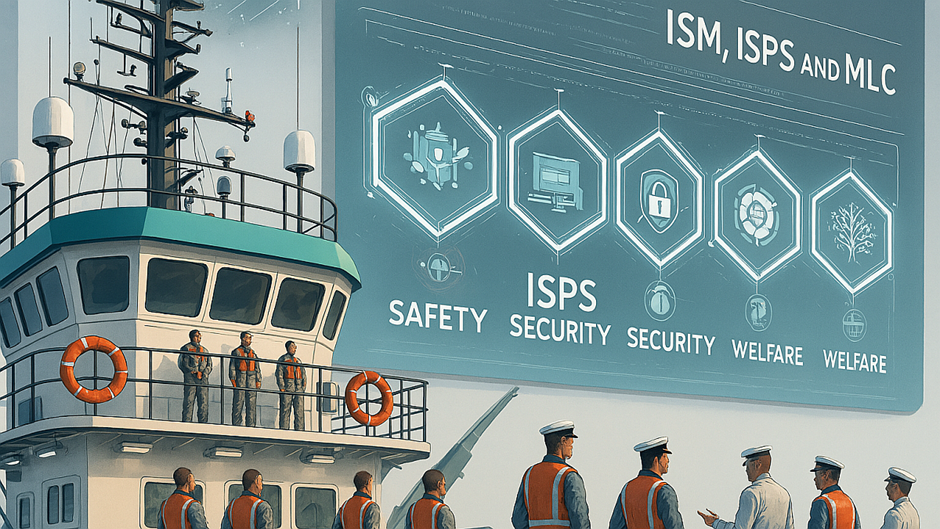
SIRE 2.0 goes beyond a snapshot of a ship’s day to a real-time assessment of how the ship is performing (Source: Ozgun Altintas / DALL-E)
In this sense, SIRE 2.0 transforms the ISM Code from a document-based requirement into a living management system. For auditors, the inspection no longer revolves solely around procedural compliance, but serves as a measure of how effectively safety is being conducted and practiced on board.
The application of SIRE 2.0 to the International Ship and Port Facility Security (ISPS) Code also moves security from a static compliance checklist to a dynamic awareness and response system. Under the conventional ISPS approach, inspectors typically reviewed drills, visitor logs, access control measures and security documentation. SIRE 2.0 goes further by examining behavioral security: how actively the crew recognizes and responds to potential threats, how involved the Ship Security Officer (SSO) is in the day-to-day activity on board, and whether access control procedures are truly followed when inspections are not imminent.
Security, under this model, becomes more than a paper requirement – it becomes ingrained in the routine on board ships.
A similar development is evident in the approach of the Maritime Labor Convention. The MLC addresses not only the legal minima for working conditions, but also the wider concept of seafarers’ welfare and its inextricable link with safety. SIRE 2.0 reflects this by looking at factors such as fatigue management, morale, management communication and crew cohesion. It asks whether rest hour requirements are being adhered to in practice, whether team dynamics support mental wellbeing, and whether staffing levels are not only compliant but operationally sustainable.
Instead of seeing the human element as secondary, SIRE 2.0 places it at the center of ship performance and safety.
As the system matures, the implications extend far beyond individual inspection reports. SIRE 2.0 creates a feedback loop that supports safer, smarter and more transparent operations in the maritime industry.
One of the key innovations is the move to risk-based verification. Instead of applying a uniform checklist to all ships, inspections are now shaped by ship-specific risk profiles. These include historical performance, technical complexity, operational areas and previous deficiencies. This allows charterers, major oil companies and verification departments to make contextualized decisions based on a comprehensive risk picture. For operators that demonstrate a strong safety culture, this could lead to shorter approval times and more stable commercial opportunities.
Another advantage is the ability to collect and analyze data across fleets, which will transform training and skills development. With a more granular understanding of recurring deficiencies – whether it’s confined space entry, work clearance protocols or machine isolation – training can become customized and proactive. Instead of generic content, companies can offer programs that directly address observed challenges. This will also improve skills management systems by providing real-world behavioral data to complement qualifications.
In addition, SIRE 2.0 provides a new lens through which to measure environmental, social and governance (ESG) performance. As scrutiny intensifies on social responsibility in shipping, behavioral information captured during SIRE 2.0 inspections provides quantifiable indicators of crew well-being, leadership accountability and workplace safety. In the future, these indicators may become an integral part of ESG reporting, investor due diligence and key performance indicators (KPIs).
The system also reinforces feedback mechanisms under the ISM Code. Traditionally, safety management system reviews have been based on indicators such as incidents or incidents. With SIRE 2.0, companies can integrate real-time observational data into SMS reviews. If inspectors routinely observe confusion in risk assessments, lifeboat drills or designated roles, companies can review procedures and reinforce training proactively – before deficiencies escalate into incidents.
“This is not an effort to catch crews unprepared”
Finally, SIRE 2.0 increases transparency and accountability. Its digital, behavior-driven structure provides consistency between inspections, reducing subjectivity and ensuring that findings are evidence-based. This empowers both operators and inspectors while reinforcing a leadership culture where accountability extends from the bridge to the boardroom.
In conclusion, SIRE 2.0 is not just a more thorough inspection regime, but a platform for an ongoing dialog between ship and shore, management and crew, policy and practice. It forces industry to ask challenging but necessary questions: are our safety systems practical? Do they allow real-time decision-making? Is our culture one that rewards transparency and encourages speaking up?
While SIRE 2.0 presents clear challenges, it also offers a timely opportunity. If fully embraced, it has the potential to drive measurable improvements in safety performance, crew welfare and operational integrity – creating a maritime industry that is not just compliant, but truly resilient.
Source: here
The first Constellation frigate is only 10% complete with the design still being finalized
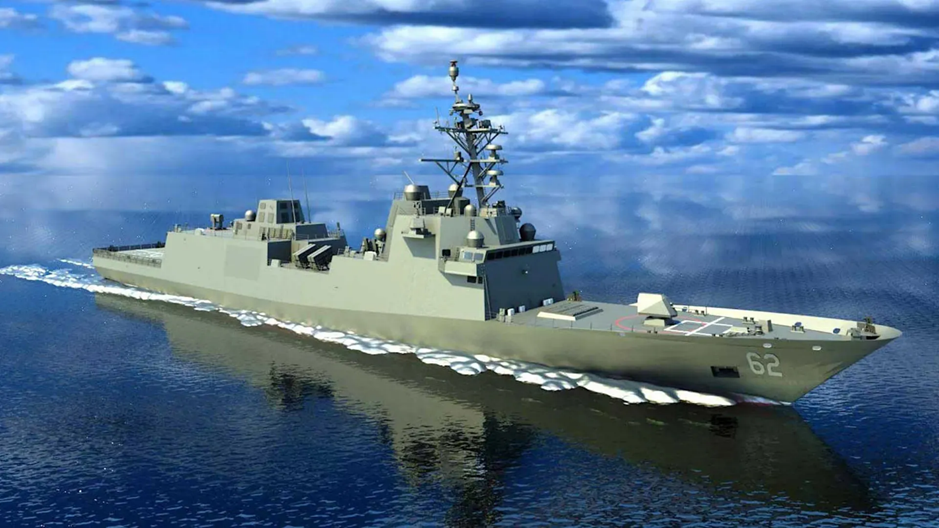
The Constellation-class design is still in flux, with only 15% in common with the frigate on which it is based, not 85% as planned.
The first Constellation-class frigate for the U.S. Navy is 10% complete, more than two years after construction began and nearly five years after the ship was originally awarded the contract. Work also continues despite the continued absence of a firm functional design for the ship, which is still weeks or even months away from being finalized and approved.
Major changes to the Constellation configuration compared to the Fregata Europea Multi-Missione (FREMM) have already led to serious delays and cost increases, and there are growing questions about the future of the program. A key goal of the program was to get a design into service that would need only relatively minor modifications to make it ready for Navy use, which would help keep the work on schedule and on budget. Now the opposite has happened.
Mark Vandroff, senior vice president of government affairs at Fincantieri Marine Group, confirmed the status of progress on the USS Constellation ‘s construction and provided an update on the program to TWZ ‘s Howard Altman at the Navy League’s Sea Air Space 2025 exhibition earlier this week. 19FortyFive first reported that the Constellation-class flagship was just 10% complete last month, citing an unnamed source.
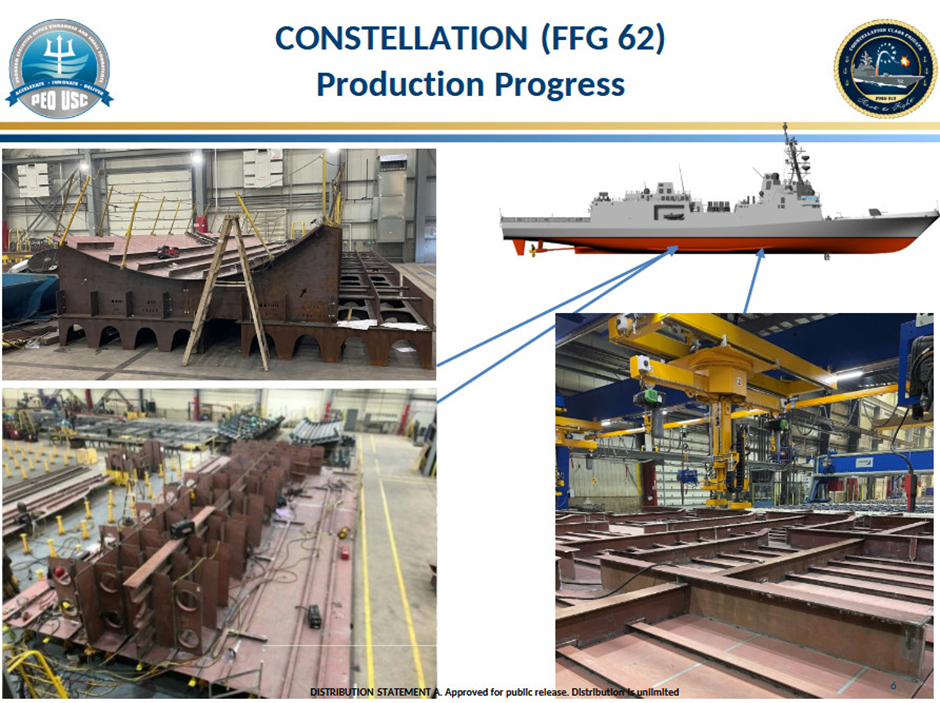
A slide from a 2023 briefing by the Naval Sea Systems Sea Systems Command (NAVSEA) showing work on the USS Constellation. USN
“The first ship is under construction in Marinette [, Wisconsin], about 10% ready,” Vandroff said. “We’re working to finalize the design with the Navy. That has progressed. We’ve made a lot of progress in the last year, and we expect to have the functional design completed here in late spring, early summer.”
The Navy first announced in 2020 that it had chosen Marinette Marine of Wisconsin, a wholly owned subsidiary of Italy’s Fincantieri, to build the Constellation-class. Construction of the USS Constellation began in August 2022. The Navy currently has a total of six ships on order, out of what is expected to be an initial installment of at least 10 frigates. The first example is scheduled to be delivered in 2029.
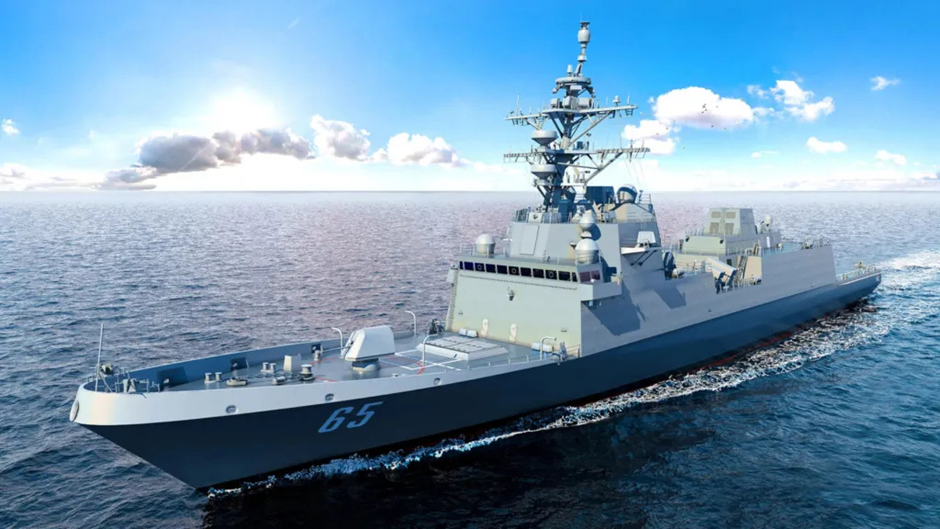
A rendering of the future USS Lafayette, which is currently expected to be the fourth Constellation-class frigate built. USN
“What I would say is that with the Navy, we are converging the design,” Vandroff added when specifically asked for an update on the Constellation-class design changes to the FREMM’s Constellation-class FREMM. “You know, we’re responsible for producing the functional design. The Navy has to approve the functional design. So, as we go back and forth to get our design fully approved by the Navy, we’re converging toward that final design.”
The Constellation-class design has already increased significantly in physical size and overall displacement over the baseline FREMM configuration, which has raised concerns about expected performance. Substantial changes have also been made to the overall configuration and it is understood that there is now only about 15% in common between the design of the Navy and the Franco-Italian parent. The original target was 85% commonality.

An infographic from around 2021 detailing how significantly the Constellation-class design will differ from the FREMM parent. USN via CRS An infographic detailing how significantly the Constellation class design will differ from the FREMM parent. USN via CRS
Design changes have also contributed to major delays and increased costs. The original plan was for the USS Constellation to be delivered in 2026. The Navy also targeted a unit cost of $1 billion, or even less, as frigate production ramped up. More recent estimates put the price for each of the ships at about $1.4 billion.
It is important to emphasize here that the Navy organized the FFG(X) frigate competition that led to the Constellation class with an explicit focus on proven, production models to help reduce the risk of cost increases and schedule delays. FREMM variants are in active service today with the Italian, French, Egyptian and Moroccan navies. Several more are under construction, including for the Indonesian Navy.
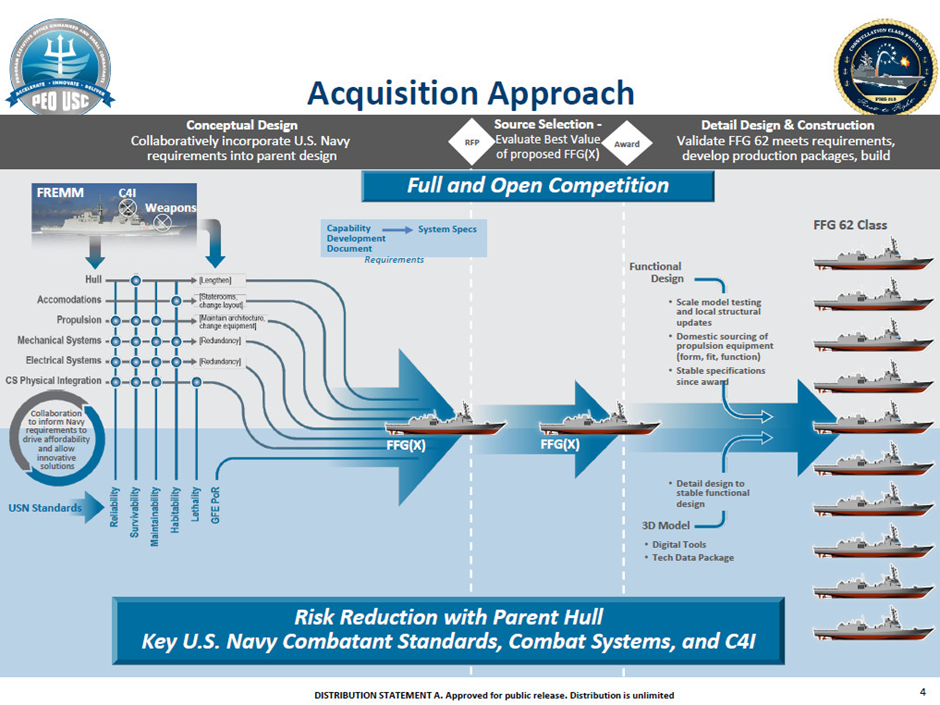
A slide from a NAVSEA briefing in 2022 showing the acquisition approach for the Constellation class from the parent FREMM FREMM. USN
Other factors, including global economic disruptions due to the COVID-19 pandemic and labor issues in the U.S. shipbuilding industry, have also hampered work on the Constellation class. There has been talk in the past about hiring a second shipyard to help produce the frigates, as well as bringing allies and partners into the program, which could help reduce unit costs through economies of scale.
“So in the modernizations we’ve done in Marinette, we’re very confident that we have enough space, the right space, the right technology, to build two frigates a year for the U.S. Navy workforce,” Fincantieri’s Vandroff told TWZ. “I think we have the same problems as almost everyone else in the U.S. shipbuilding industry. We certainly would like more workers. We certainly would like more workers in the steel trade. There is a nationwide shortage of welders, shipfitters [and] to a lesser extent, electricians.”
“We’ve made progress on that, but that’s one of the challenges we’re working through, just like any other shipyard.”
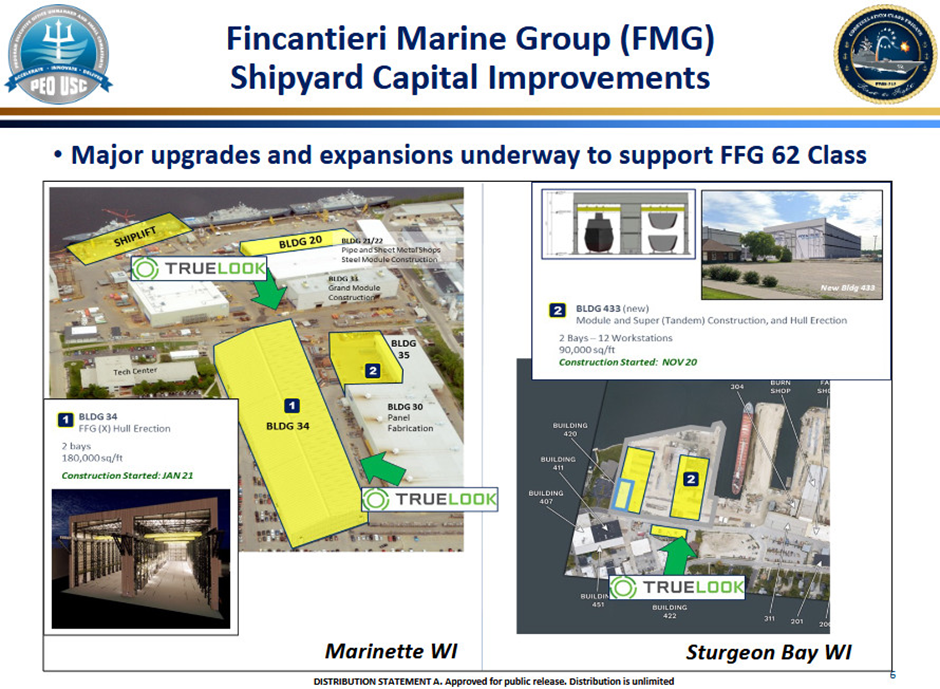
Another 2022 NAVSEA briefing slide detailing the work Fincantieri has done to expand its physical infrastructure to support Constellation-class production . USN
The Constellation class isn’t the only Navy shipbuilding program facing delays and rising costs. The U.S. shipbuilding industry, when it comes to producing military and commercial ships, has been contracting steadily for decades. In recent years, the capacity of US shipyards, which also impacts the maintenance and modernization of existing ships, has become a cause célèbre. This was highlighted just yesterday by a new executive order from President Donald Trump.
“The commercial shipbuilding capacity and maritime workforce of the United States have been weakened by decades of government neglect, leading to the decline of a once-strong industrial base, while empowering our adversaries and eroding the national security of the United States,” the executive order, titled “Restoring America’s Maritime Dominance.” states in the opening. “Both our allies and our strategic competitors produce ships for a fraction of the cost needed in the United States. Recent data shows that the United States builds less than 1% of commercial ships globally, while the People’s Republic of China (PRC) is responsible for producing about half.”
TWZ has previously reported in detail on the massive and worrying disparity between the United States and China in shipbuilding.
A US Office of Naval Intelligence briefing slide showing the different shipbuilding capabilities of the US and China. ONI
The new executive order directs “the Secretary of Defense, Secretary of Commerce, Secretary of Transportation, and Secretary of Homeland Security” to “conduct a review of shipbuilding for the use of the United States Government and submit a report to the President with recommendations for increasing the number of participants and competitors in U.S. shipbuilding and reducing cost overruns and production delays for surface Underground and unmanned programs” within 45 days. “This report shall include separate detailed and prioritized lists of recommendations for the U.S. Army, Navy and Coast Guard.”
Much of the rest of the executive order is in line with the proposed Shipbuilding and Port Infrastructure for Prosperity and Security for America Shipbuilding and Port Infrastructure Act, or SHIPS Act, which a bipartisan group of lawmakers introduced last year and which you can read more about here.
“We will set realistic, achievable programs and commit to them. We will eliminate waste and inefficiencies that drain resources without delivering results. We will demand accountability from our shareholder enterprise, because every dollar, every day … counts,” Secretary of the Navy John Phelan recently confirmed at a meeting at the Sea Air Space 2025 convention earlier this week. “To avoid repeating the mistakes of poorly executed programs, we will work closely with the shipbuilding industry to calculate risk more effectively to ensure that every defense dollar spent leads to tangible and measurable results.”
“Change is coming and my responsibility is to make sure we have the right people in the right places on the right platforms,” he added.

It remains to be seen how all this might affect plans for the Constellation class.
“We are at a critical point with Constellation. It started by saying we’re going to take the FREMM concept, 85 percent complete, add 15 percent, and then go straight to construction,” Rob Wittman, a Republican in the Virginia House of Representatives who is currently vice chairman of the House Armed Services Committee, said during a panel discussion at Sea Air Space 2025. “We’re looking now, [it’s] over cost, over budget, because that’s reversed. Now it’s 15% original design [and] 85% add-ons.”
“The question is, are we at a point where we either recover quickly and get back on track, or get back on schedule, get back on budget – I don’t know if you could do a schedule – or say, maybe we’re too far along with this and we’re going in a different direction,” Wittman continued. “The Navy is going to have to ask that question now. It can’t put it off into the future.”
Members of Congress have already been increasingly open about their dissatisfaction with the state of the Navy’s Constellation-class Constellation program, and major decisions on the Navy’s frigate plans appear to be increasingly on the horizon, with the USS Constellation just 10% completed and still years away from delivery.
Source: here
The Defiant drone ship has been approaching a DARPA demonstration at sea for months
The USX-1 Defiant, which will sail without humans on board and is designed for mass production, is undergoing tests ahead of its long-duration cruise.
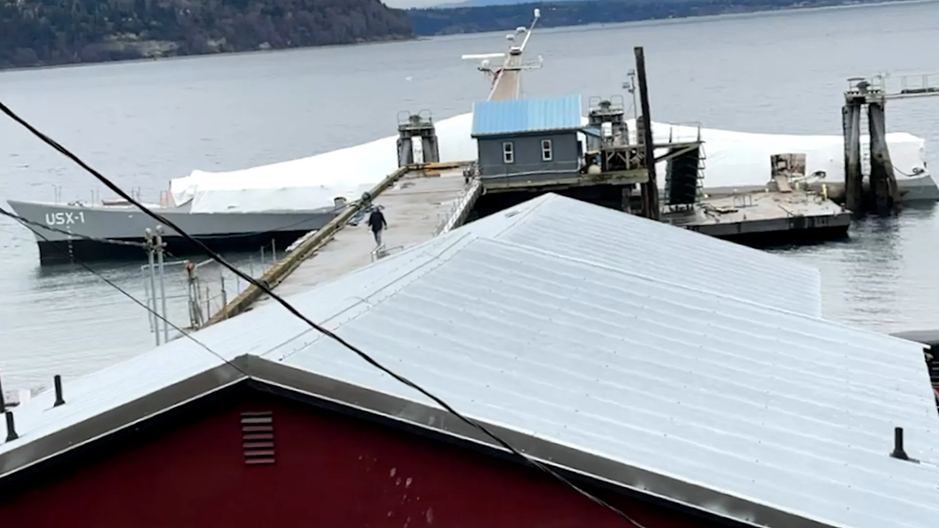
The US military’s US X-1 Defiant medium-sized drone ship , with a hull-like profile, is currently undergoing tests at the dock ahead of a planned months-long cruise to demonstrate its basic capabilities. Designed from keel to unmanned onboard navigation and for efficient mass production, Defiant is expected to eventually be handed over to the US Navy for further testing, with an eye more on potential real-world missions that could aid the service’s effort to add more capable USVs to its fleets. TWZ was the first to confirm that the unmanned craft was launched after it was spotted in Washington state’s Puget Sound earlier this year.
Ryan Maatta, marine engineering manager at Serco, gave TWZ’s Howard Altman an update on the Defiant at the Navy League’s Sea Air Space 2025 exhibition earlier this week. The USX-1 was developed for the U.S. Defense Advanced Research Projects Advanced Research Projects Agency’s (DARPA) No Manning Required Ship (NOMARS) program, for which Maatta is also deputy program director.
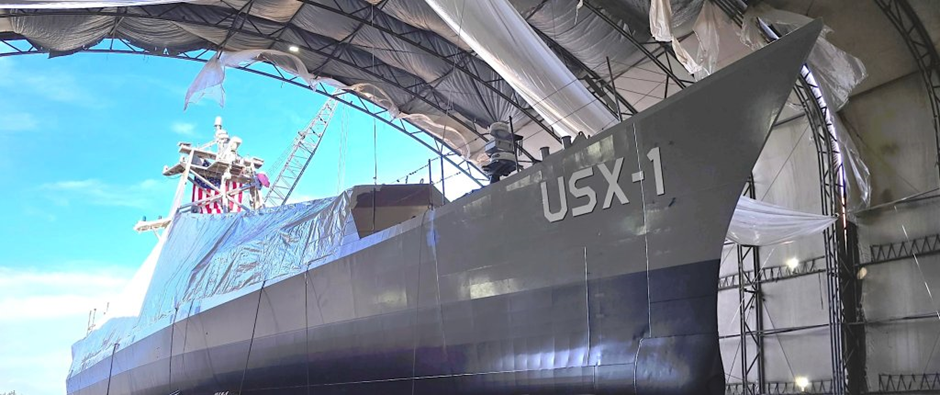
One of the few images DARPA has released so far of the USX-1 Defiant. DARPA
“We’re dock testing before delivery of the ship right now. And then we’re going to head into the typical DARPA demonstration to show that we’ve done what they set out to do with the technology,” Maatta said. “We expect to be on the water this summer as planned. If all goes well, we’ll go for that long endurance test I mentioned earlier.”
Defiant is currently docked at Naval Station Everett, a Navy facility on Puget Sound in the city of Everett, north of Seattle. The Unmanned Surface Vessel (USV) was launched from Nichols Brothers Boat Builders on Whidbey Island, just across the strait.

Some additional views of the USX-1 seen docked in Puget Sound earlier this year. Anonymous
DARPA said it expects the Defiant sea demonstration to last several months. To support this long-duration cruise, DARPA, in cooperation with the Navy, has also developed a new at-sea refueling system for the USX-1 that does not require personnel on the receiving end.

An image released by DARPA from a test of the NOMARS at-sea refueling system last year in which Defiant was not involved. DARPA
“After the DARPA demonstration, it will be delivered to SURFDEVRON at Naval Base Ventura County, and PMS 406 will be the sponsoring program office,” Maatta continued.
SURFDEVRON refers to the Navy’s Surface Development Squadron One Surface Development Squadron, created in 2019, ostensibly as a test unit. Last year, SURFDEVVRON formally evolved into Surface Development Group One (SURFDEVGRU), which now has two squadrons of unmanned surface ships. The group also oversees the two Zumwalt-class stealth destroyers in Navy service and will eventually receive the third of those ships, the future USS Lyndon B. Johnson.
PMS 406 is the Unmanned Maritime Systems office within Naval Sea Systems Command (NAVSEA).
“When we deliver to SURFDEVRON, what we’re really hoping to do is a lot of exercises with mission systems, because the DARPA demonstration doesn’t include mission systems,” added Serco’s Maatta. “So we’d like to prove the utility of the ‘R’ requirement of something like this. So what could it perform, what could it carry? And this integration of the mission system and the platform is what we’re hoping for.”
As already mentioned, the Defiant was designed from the outset to be operated without humans on board, if only to provide an extra margin of safety. The larger USVs that the Navy has experimented with to date are either converted from manned ships, or are designed to be manned optional. The U.S. military has historically classified medium USVs, such as the USX-1, as having lengths under 200 feet and displacements under 500 tons, but also being larger than designs based on fast boats and jet skis. Large USVs (LUSVs) have lengths up to 300 feet and displace up to 2,000 tons.
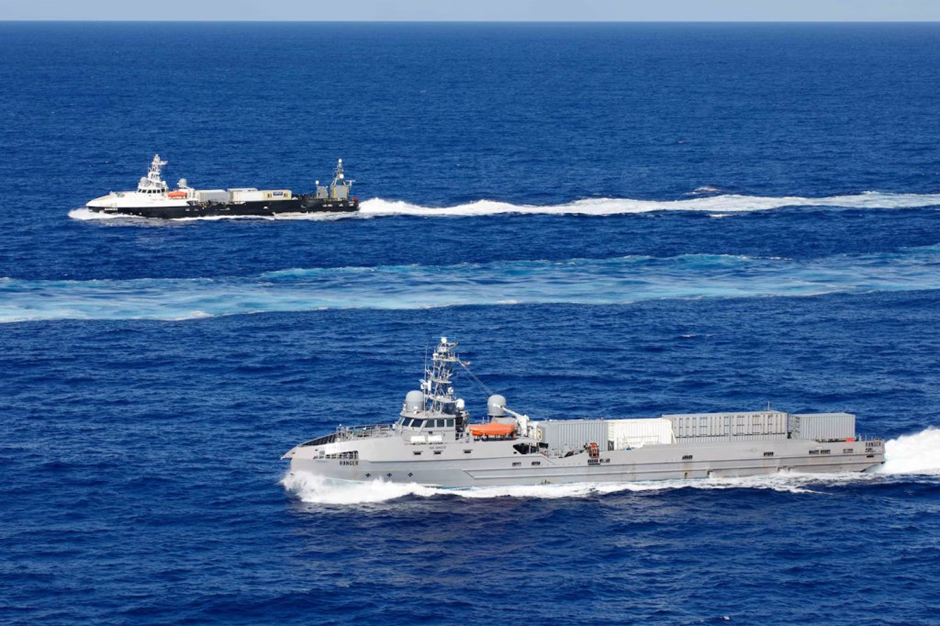
US Navy USVs Mariner, aft, and Ranger, forward, sail together in 2023. Both are converted offshore support vessels. USN
With NOMARS, DARPA’s basic proposal “was that you could go to sea for a year completely unmanned, with 90% availability, that [USVs] would be fast, cheaper to operate” and capable of sailing up to “20 knots at Sea State 3″ while carrying useful payloads, according to Serco’s Maatta. So we met those requirements.”
Below the Beaufort scale, Sea State 3 includes winds of up to 10 knots and average wave heights of about two meters, sometimes rising to a maximum of three feet.
Maatta said he could not provide additional details about the Defiant’s current specifications and capabilities and directed us to contact DARPA for more information. He described it as having a high degree of “system autonomy and navigation.”

Defiant in the water. DARPA
Although exploring how Defiant might be operationalized is not part of DARPA’s immediate plans, the USV was designed with potential integration of mission payloads in mind.
“We’re built around a number of indicative mission systems,” Maatta explained. “So podded or containerized systems. There are already quite a few in the [Navy] inventory.”
Maatta specifically highlighted a test launch of a Standard Multirole Missile 6 (SM-6) from a containerized launcher based on the Mk 41 Vertical Launch Sysem loaded on the Navy’s USV Ranger USV in 2021 as an example of a payload. Serco also showcased BAE Systems’ Adaptive Deck Launch ( ADL) system from BAE Systems , which can launch missiles from the same canisters used with the Mk 41, as another potential option.
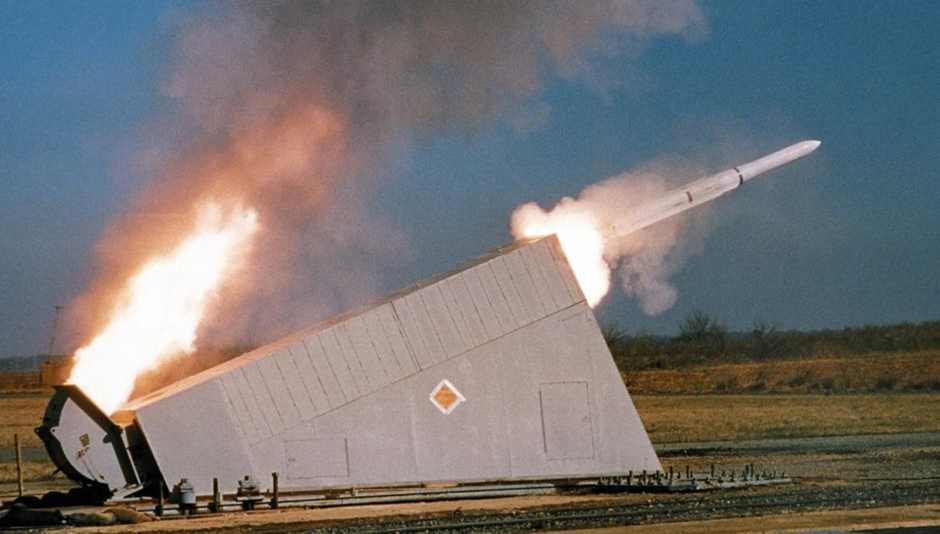
An ADL tested on land. BAE Systems
Armed with the missiles, the Defiant could be used “as an external loader for destroyers,” Maatta pointed out. “We are decommissioning all CG-47s [Ticonderoga-class cruisers] right now. There are 128 cellular vessels [VLS]. We have to make up that missile gap somehow.”
The Navy is inching closer and closer to retiring the last of the Ticonderoga, but announced plans to extend the life of three of them last year.
“There are many more [payload options] as you can imagine. C2ISR [command and control, intelligence, surveillance, surveillance and reconnaissance], those kinds of payloads,” Maatta noted. “The thing about the Defiant and MUSVs in general is that they’re big enough to carry tactically useful payloads and [do so at] tactically useful distances and [in] open water.”
Serco has also suggested in the past that logistics could be another mission set for the Defiant.
“You always have to be man-in-the-loop to fire munitions, but maybe some of the equipment or kinetics could be offloaded to an [unmanned] platform. It makes a lot of sense from a distributed logistics or distributed lethality standpoint because it’s a small, cheap platform that can go up or over the horizon,” Maatta added. “And I think once people start to play war with platforms, they’ll find a lot of value and use for something [with] that size, endurance, autonomy.”
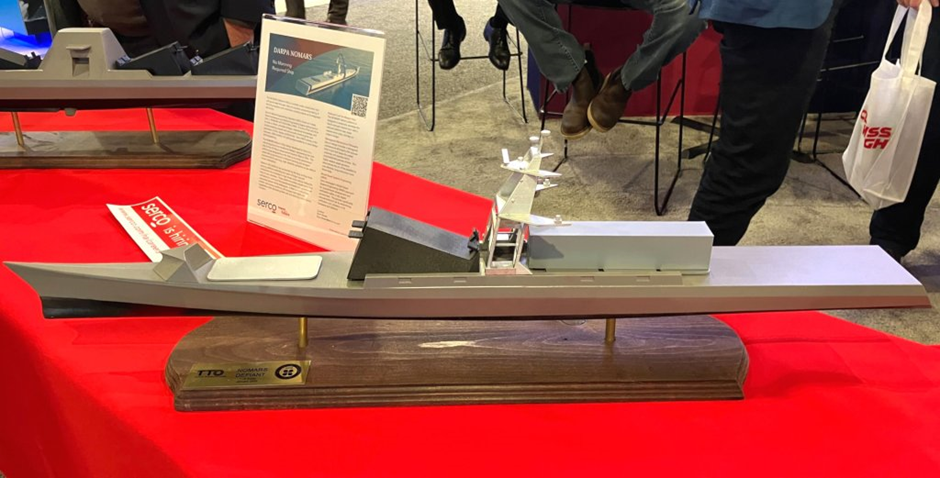
A model of the Defiant on display at Sea Air Space 2025 with an ADL installed at the bow end. Howard Altman
Talk of modular payloads, including containerized missile launchers, as well as the broader operational relevance that MUSVs offer, especially compared to smaller models, are consistent with where the Navy says it is headed with its USV plans. In January, the service announced that it was refocusing its efforts on acquiring smaller, simpler and more interchangeable drone models, rather than separate MUSV and LUSV fleets.
The Navy has also struggled in recent years with serious delays and rising costs in a number of traditional warship and manned submarine programs. That, in turn, could put a new emphasis on USVs as cheaper and more readily producible options to bolster its fleets, especially amid preparations for a potential next-generation Pacific battle against China. Serco has consistently touted the Defiant ‘s design as offering particular advantages in this regard.
“We delivered a ship in a reasonable timeframe at a reasonable cost, which is somewhat rare in today’s industry. We did this by being the main designer and contractor of the ship and by sourcing almost all the material from the industrial base and integrating it ourselves,” according to Maatta. “Rather than being a shipyard, the government and their system integrator worked together to procure all the materials and pivot when things got difficult and deliver the ship, which is more the way we used to do ships in the 1980s than the way we do ships today.”
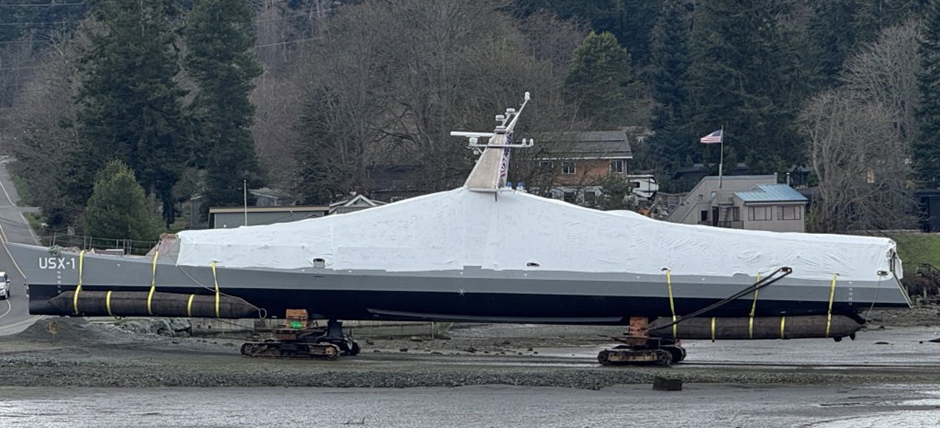
Defiant at or near the point of launch. DARPA
“They say 14 months with 14 people welded our hull together. The body can be very simplistic due to the fact that there are no personnel on board. So there are no heads [restrooms], there are no galleys, there are no passageways, there are very few penetrations through bulkheads. So it’s very modular in its construction and allows very fast hand-building,” he continued. “So the tier-three shipyards [that could produce the Defiant], there are more than 35 tier-three shipyards in the United States. The engine size that we use is produced by tens of thousands of people from three manufacturers.”
Serco has also already been exploring the possibility of larger USVs based on the Defiant design for years. That includes one called the Dauntless, which could be armed with up to four ADLs or other containerized missile launchers, among other payloads.
A model of the Dauntless concept. Howard Altman
It remains to be seen how the Defiant, or other variants or derivatives of the design, might eventually enter operational service with the Navy or any other armed forces. In the meantime, Serco and DARPA are moving toward a real-world demonstration of the drone’s basic capability to operate with a high degree of autonomy at sea for weeks, if not months at a time.
Source: here